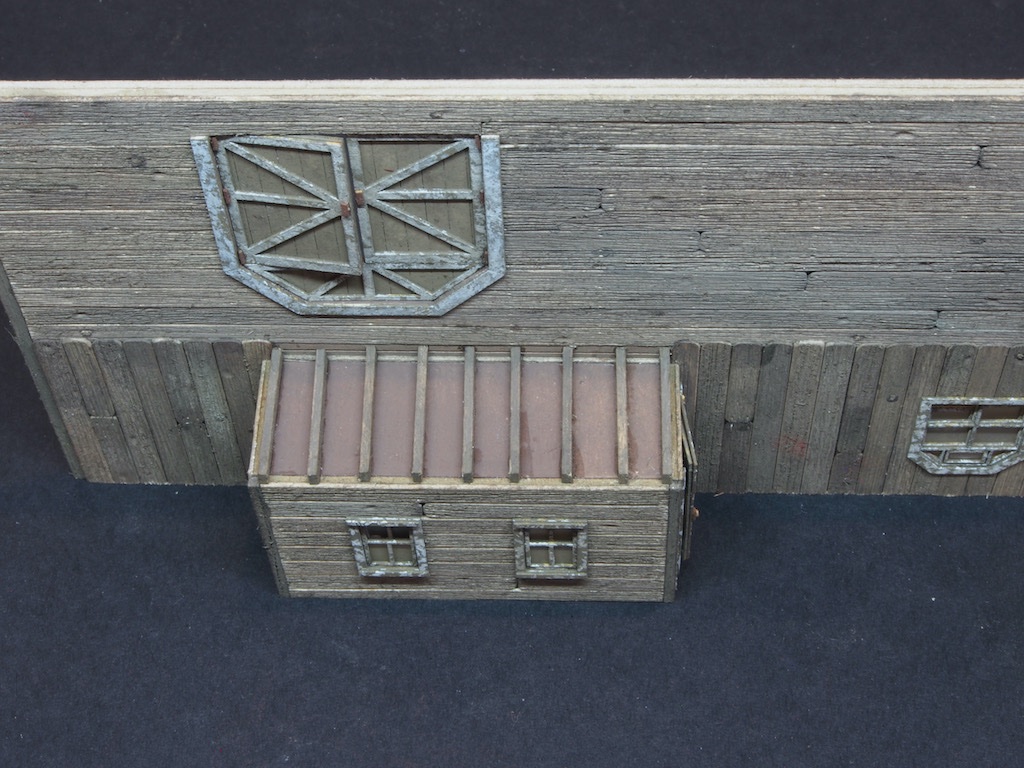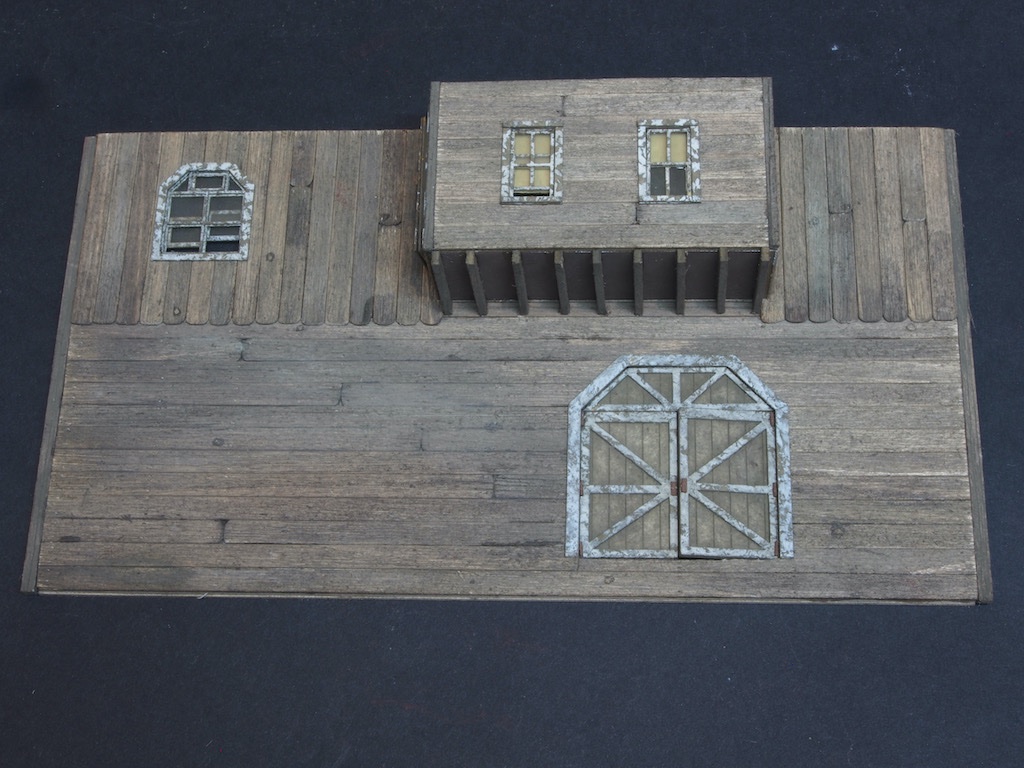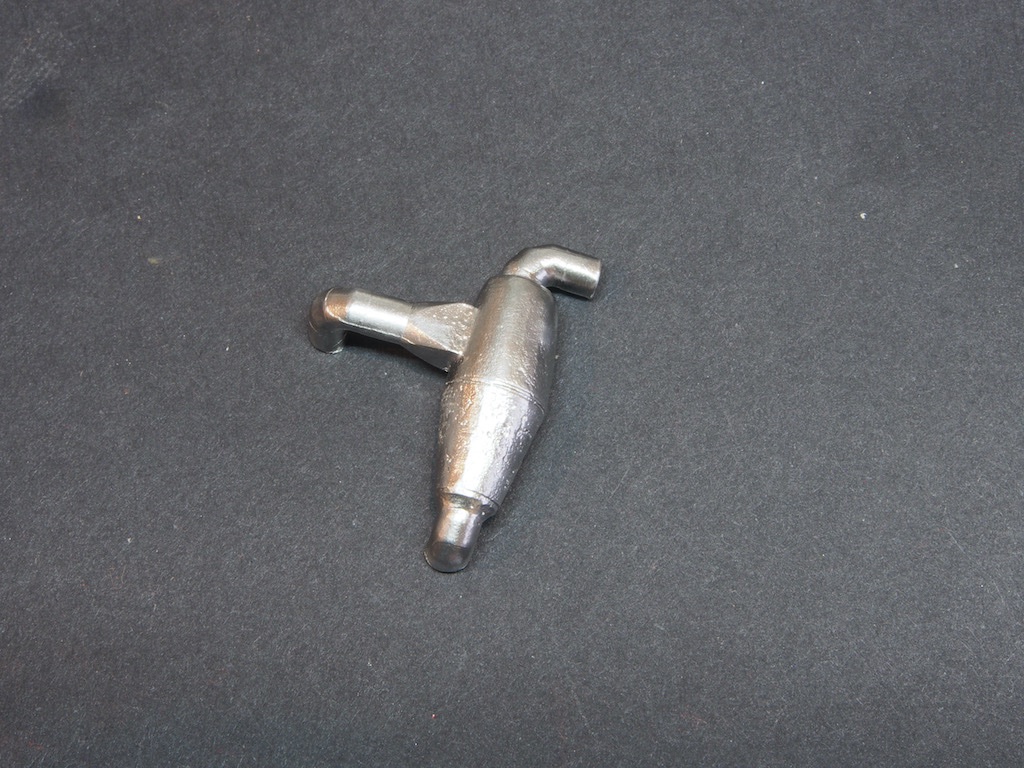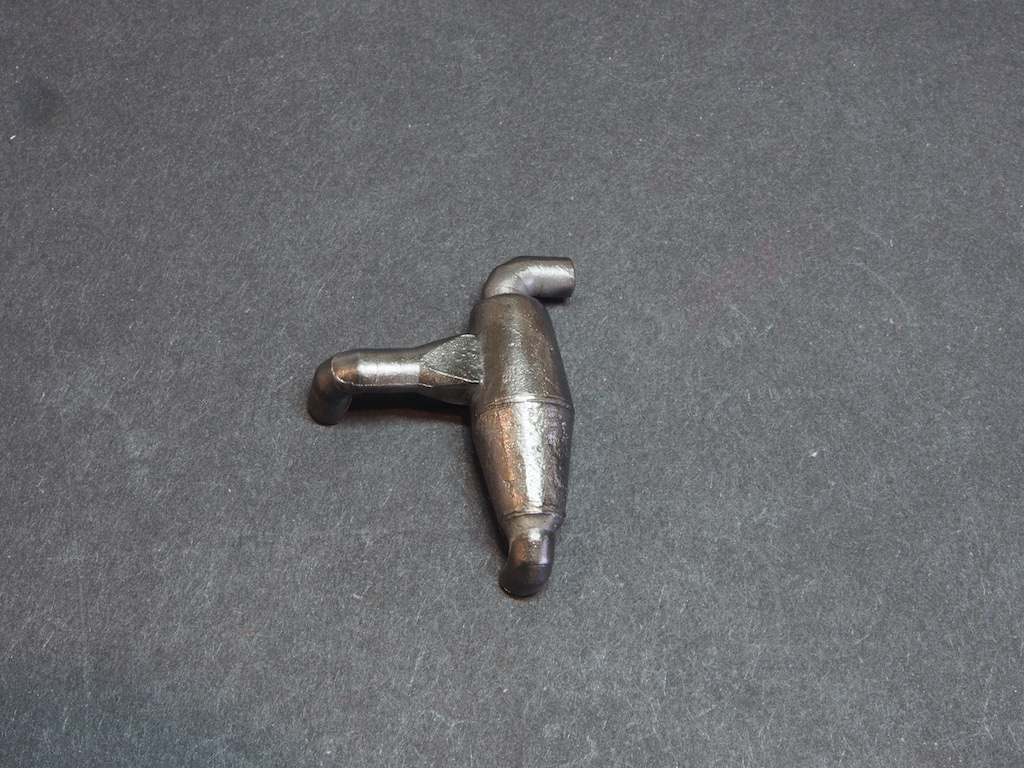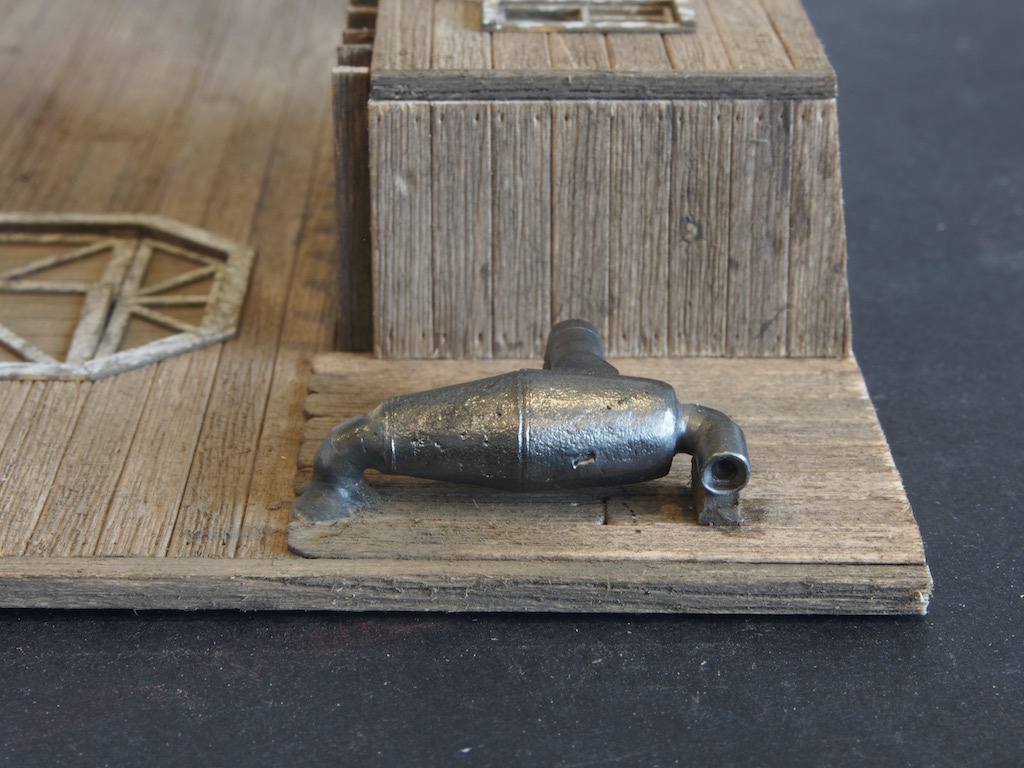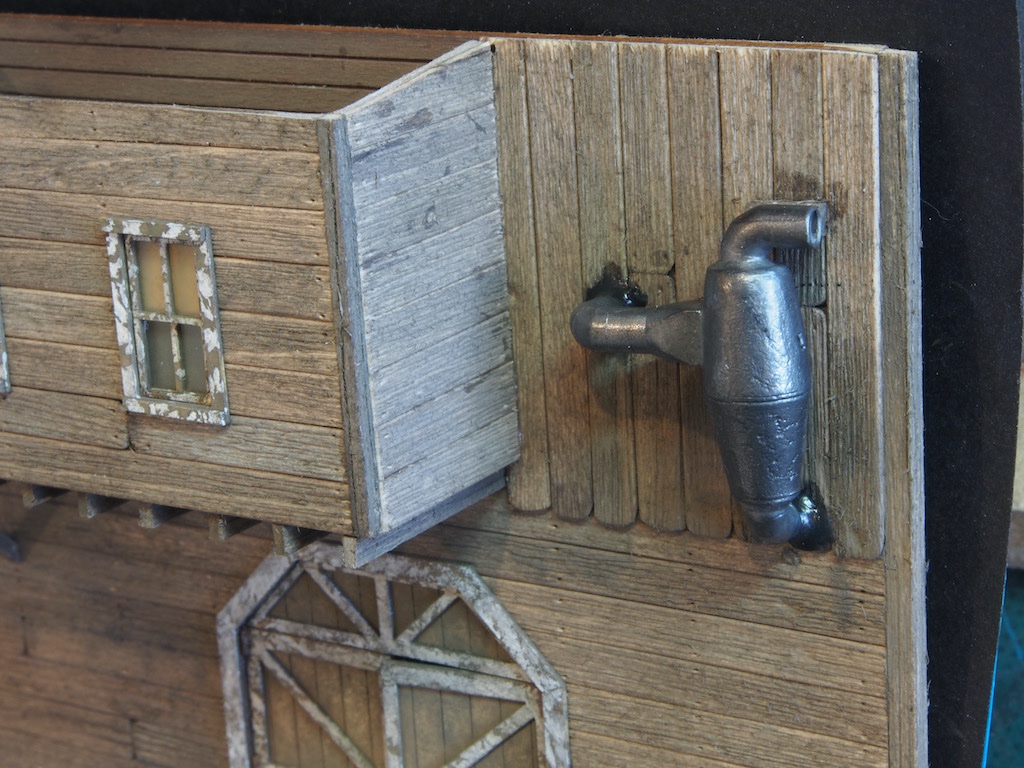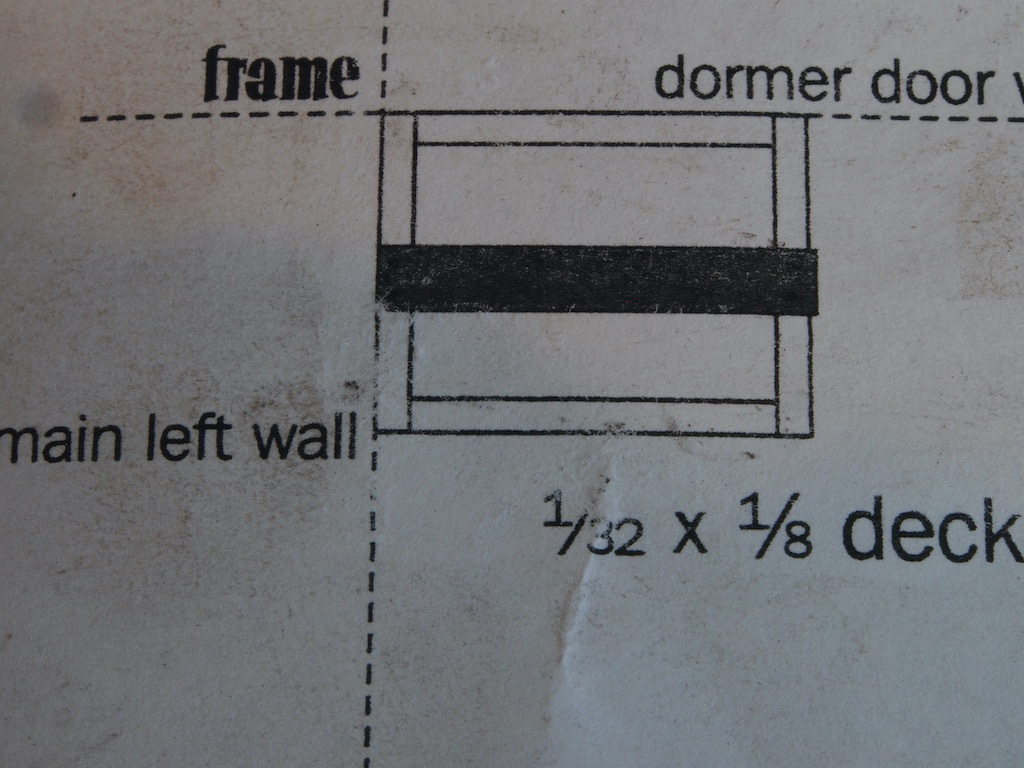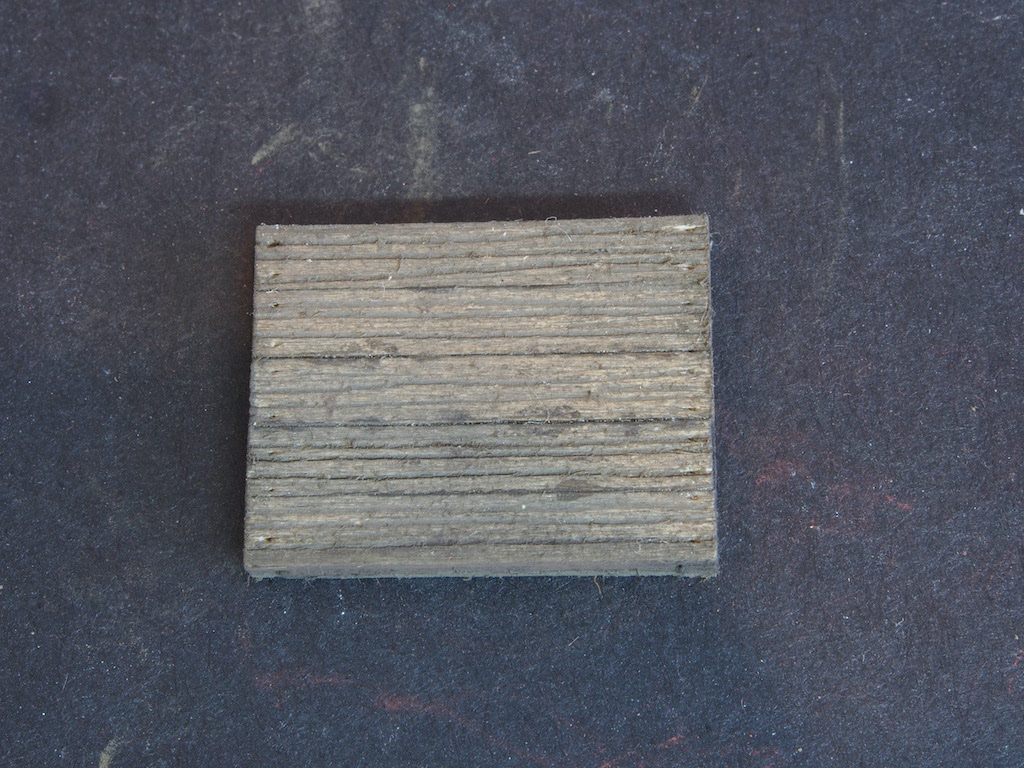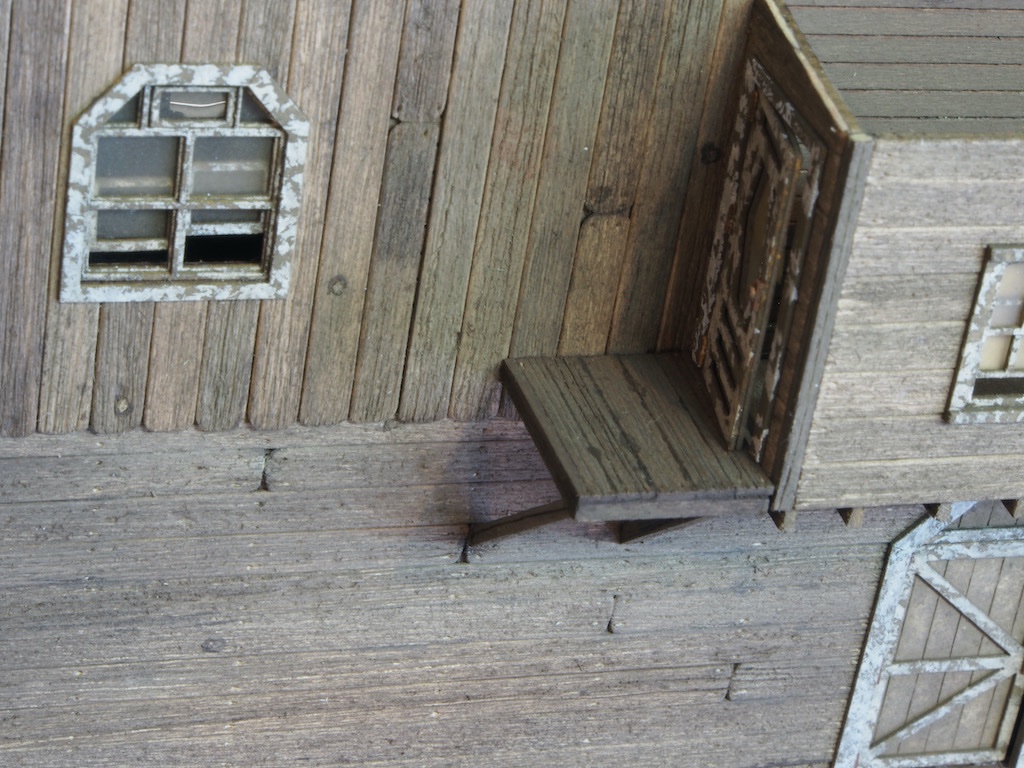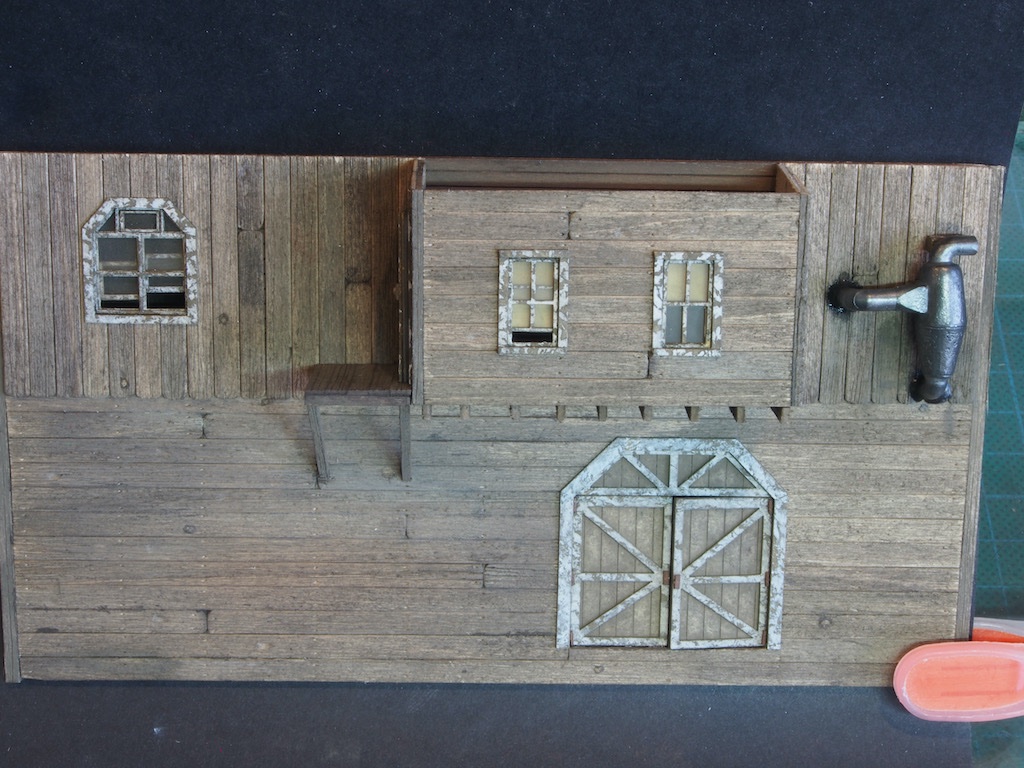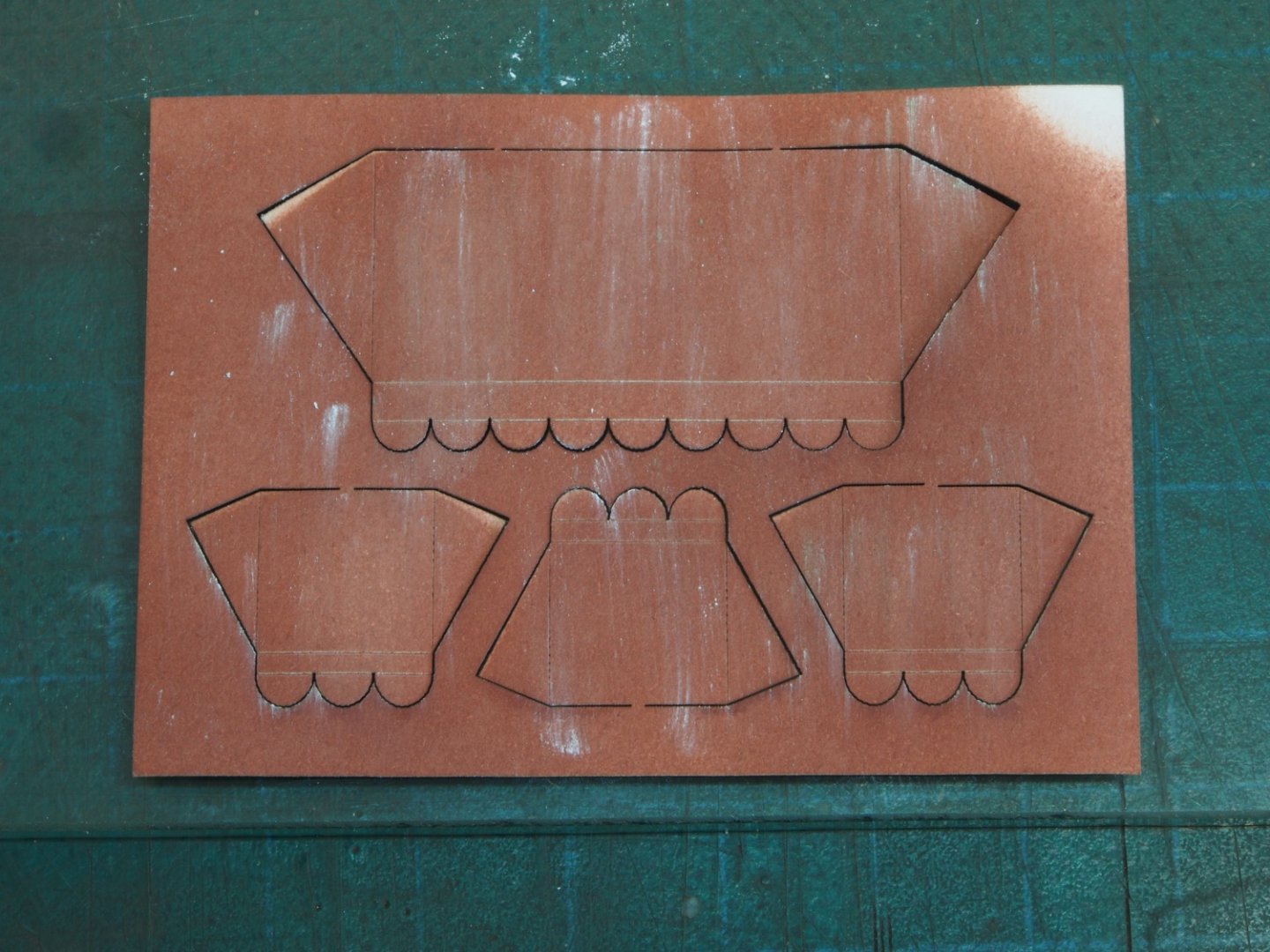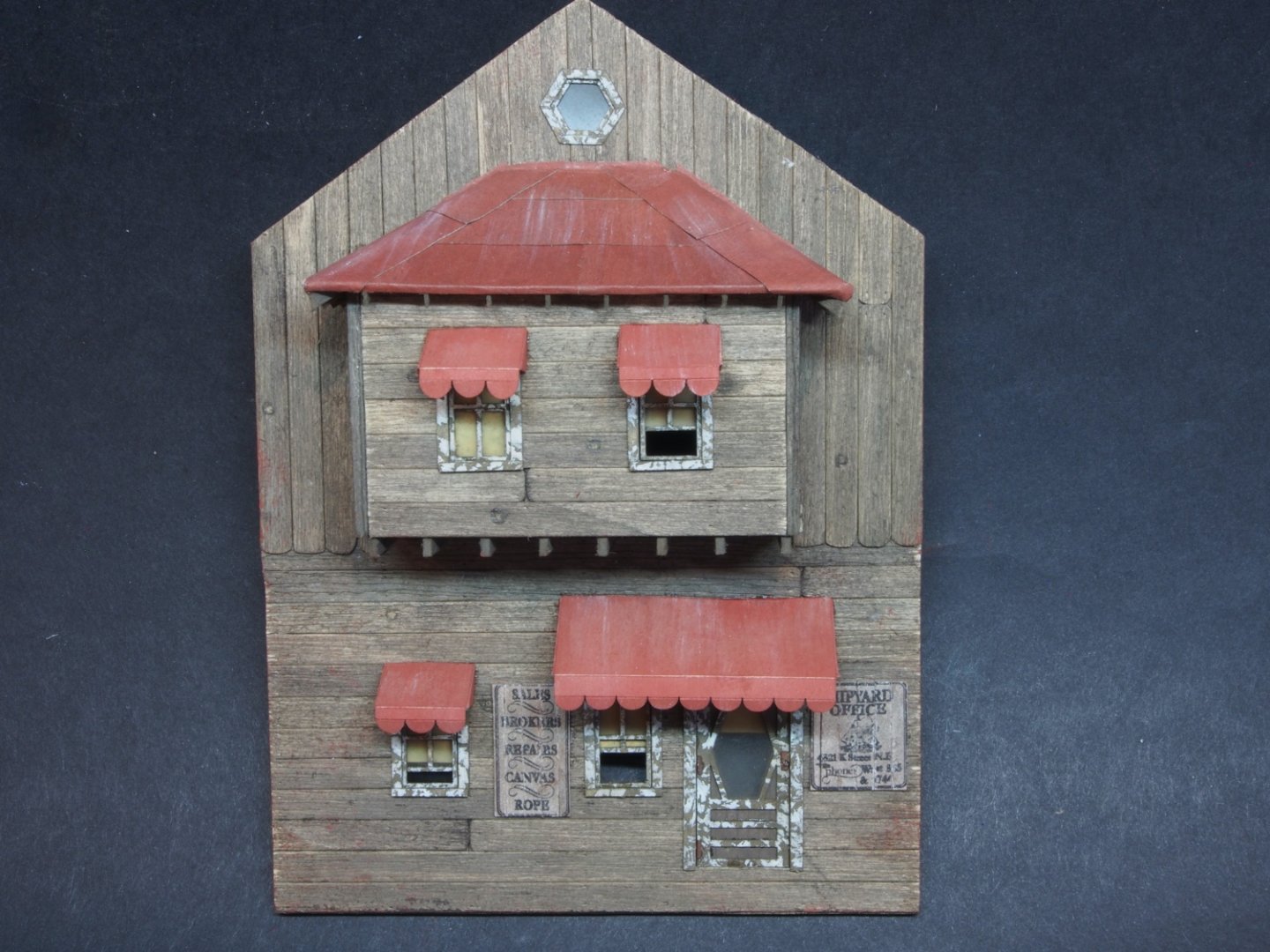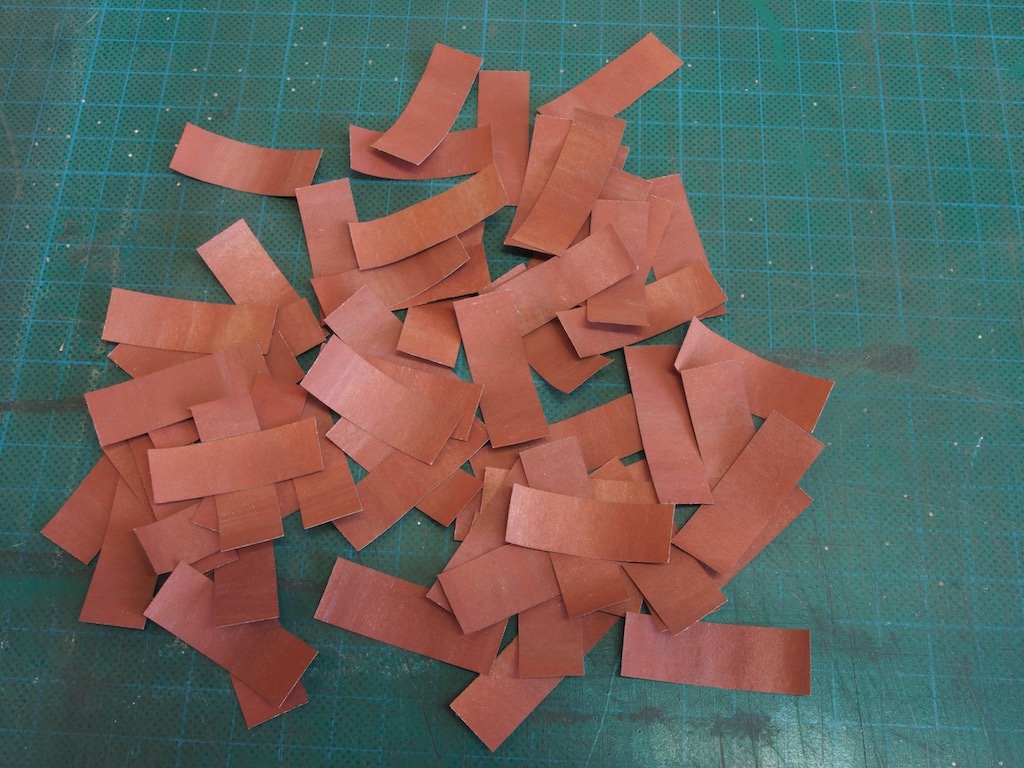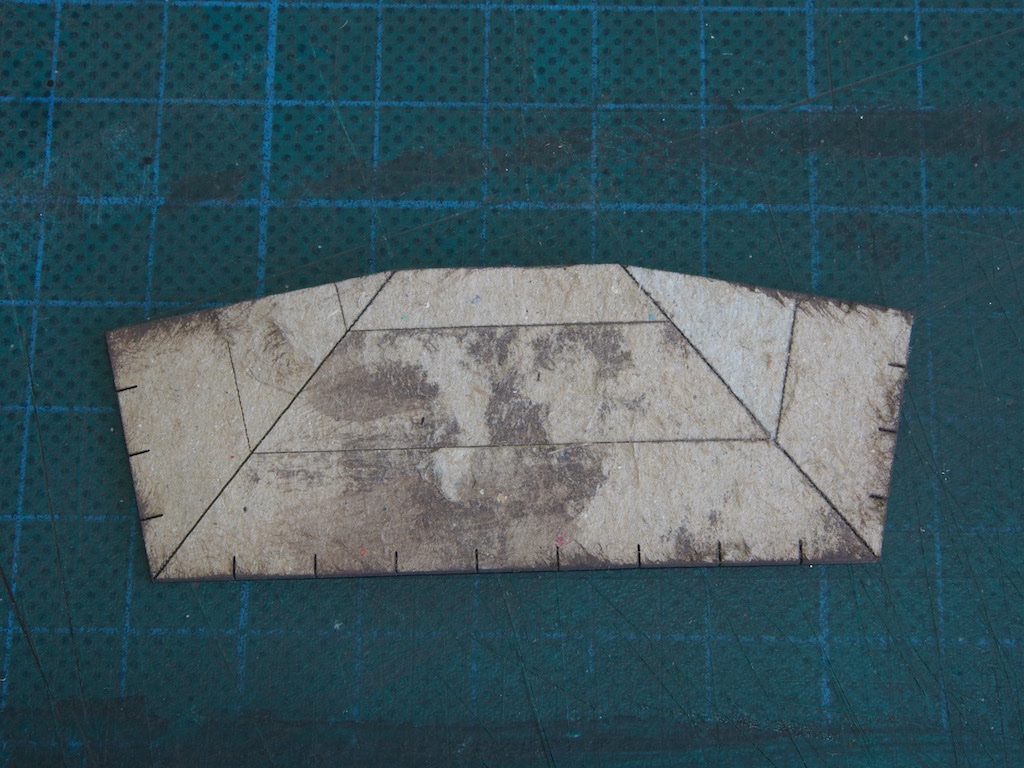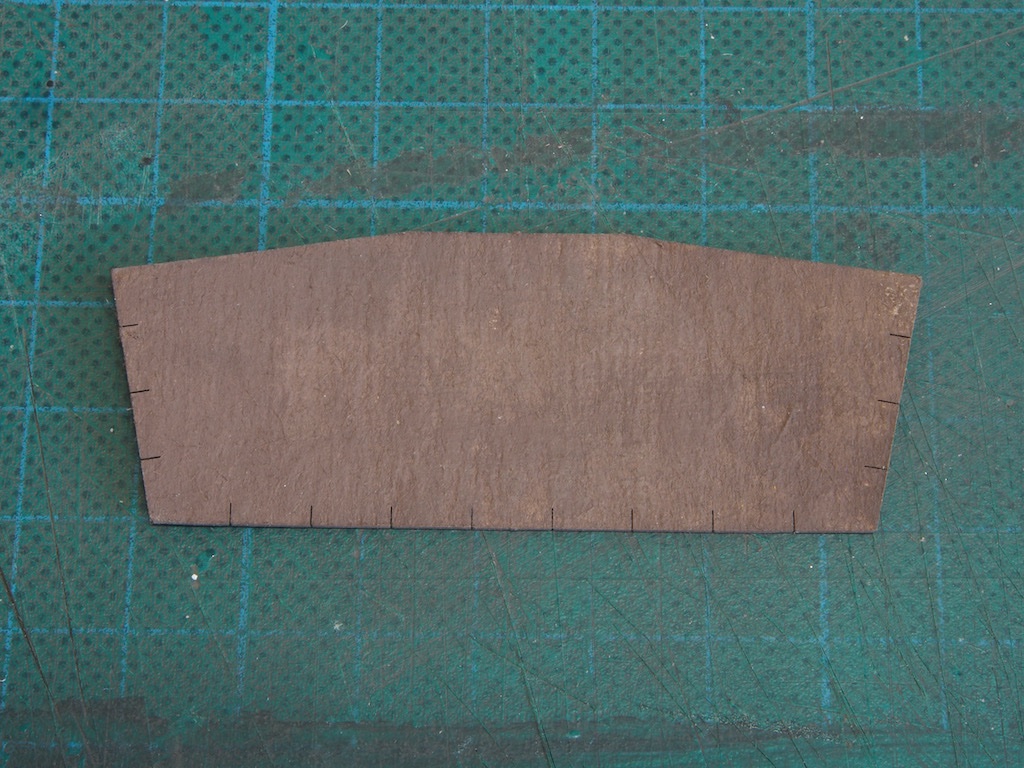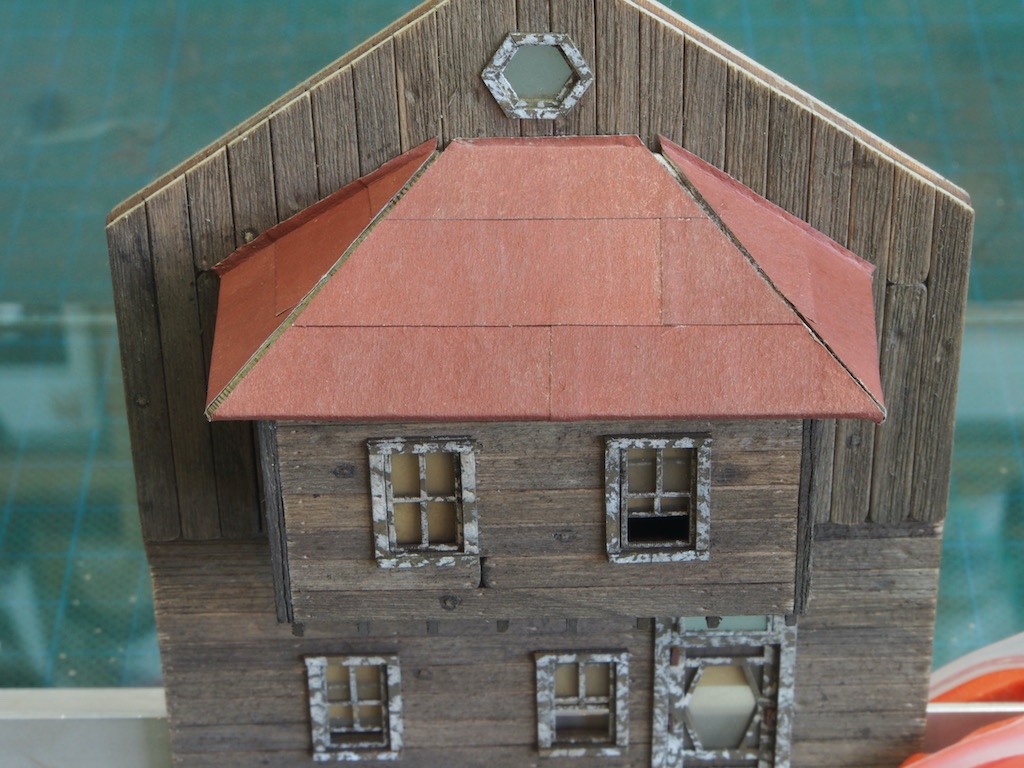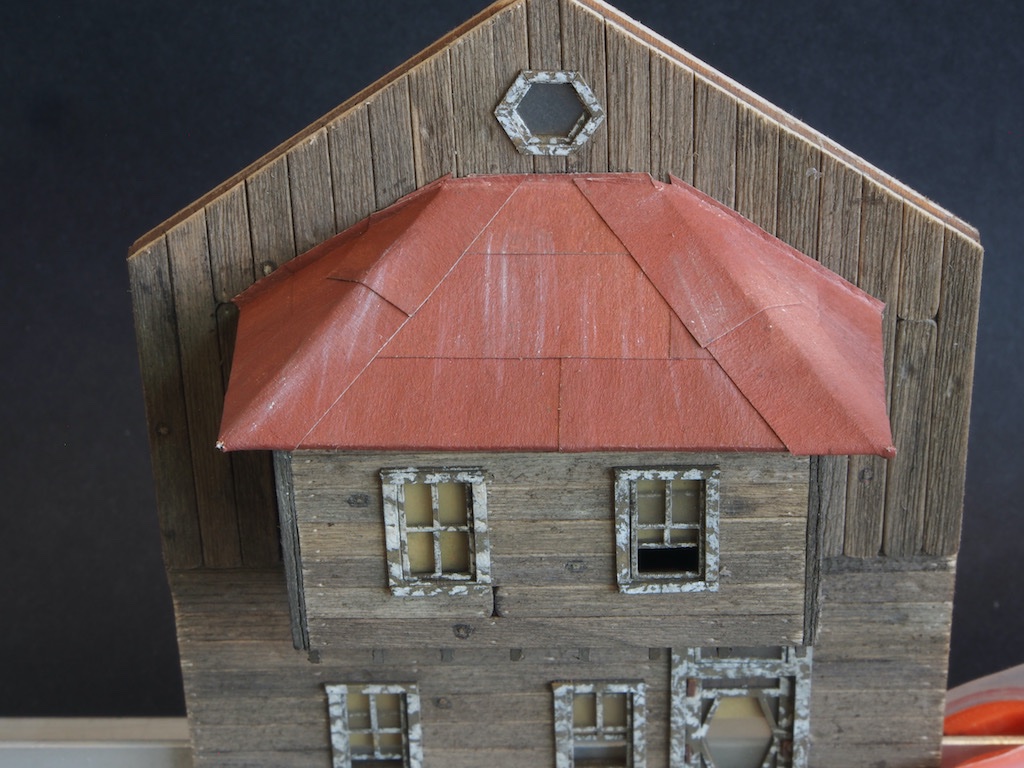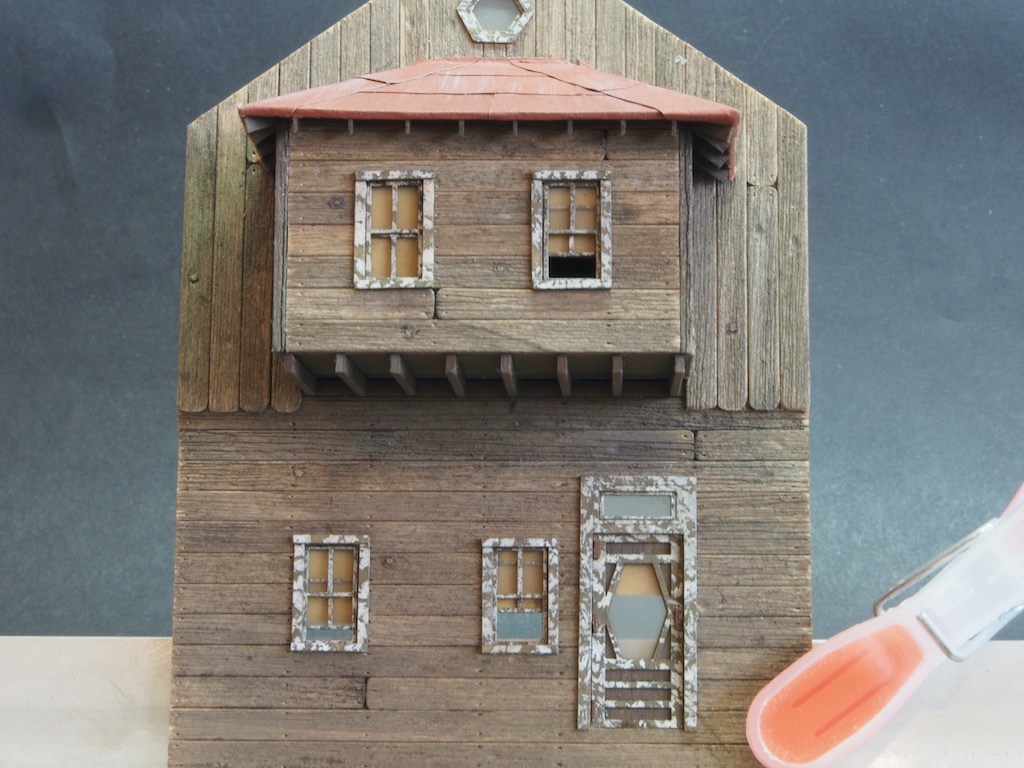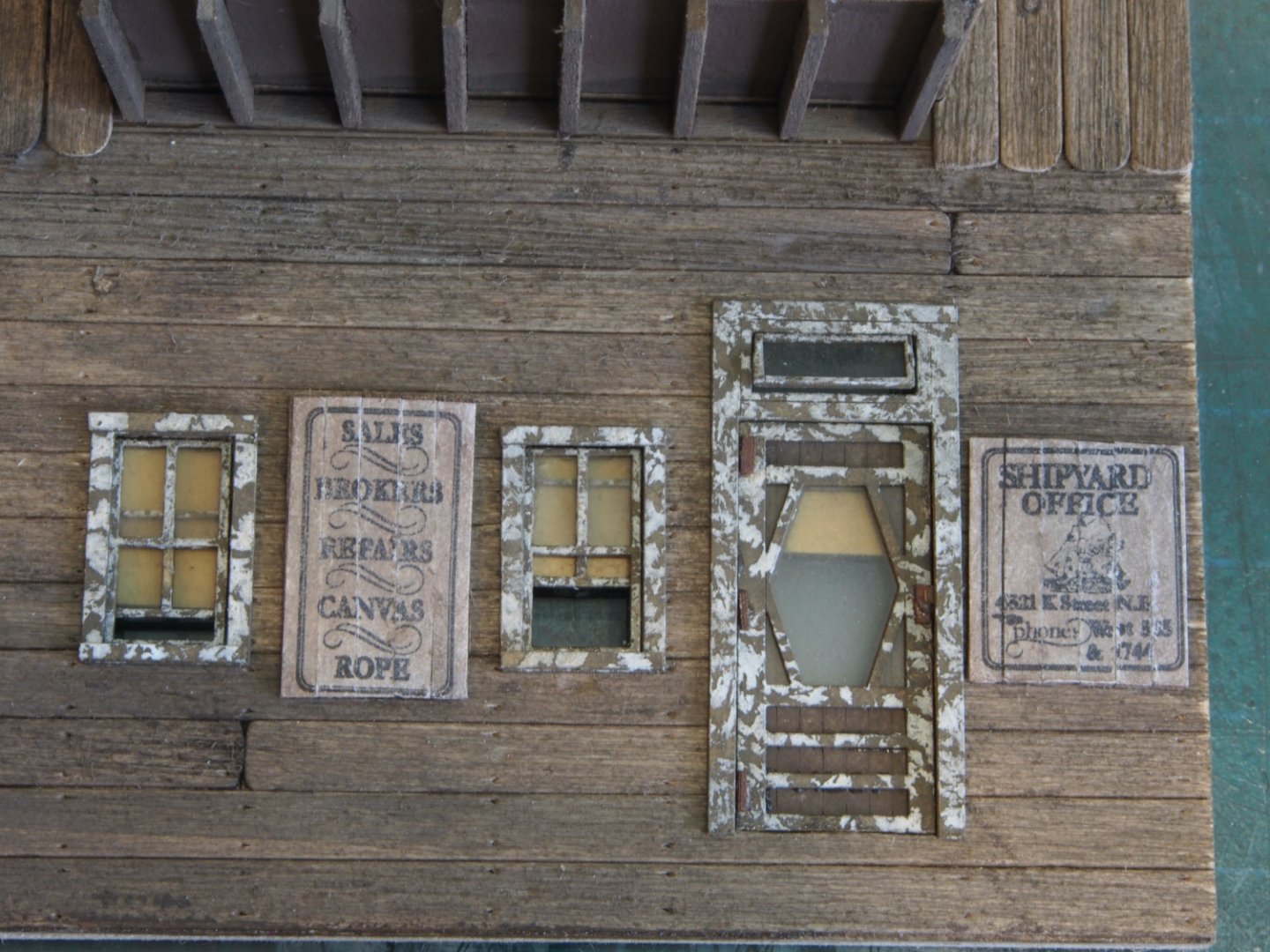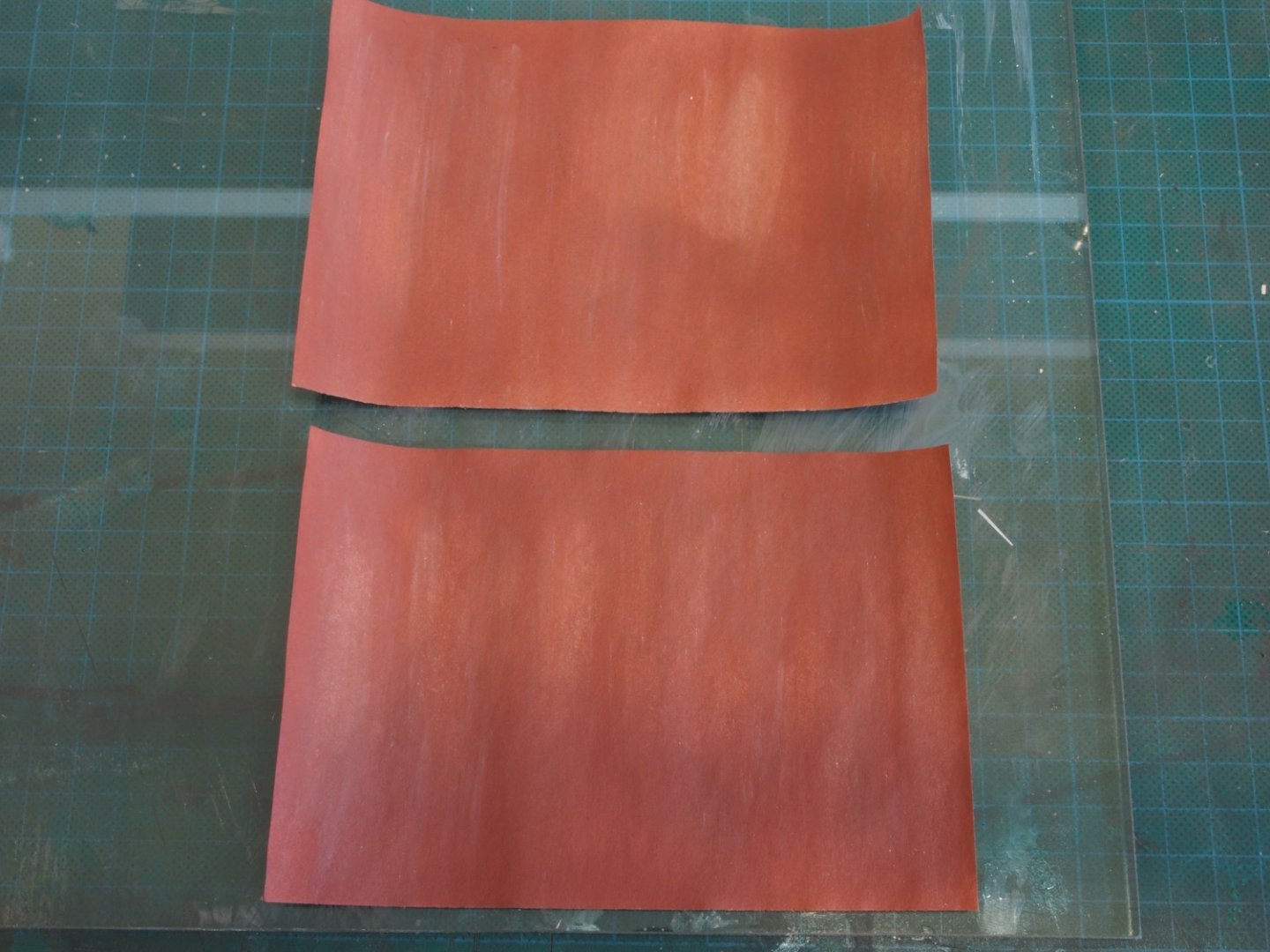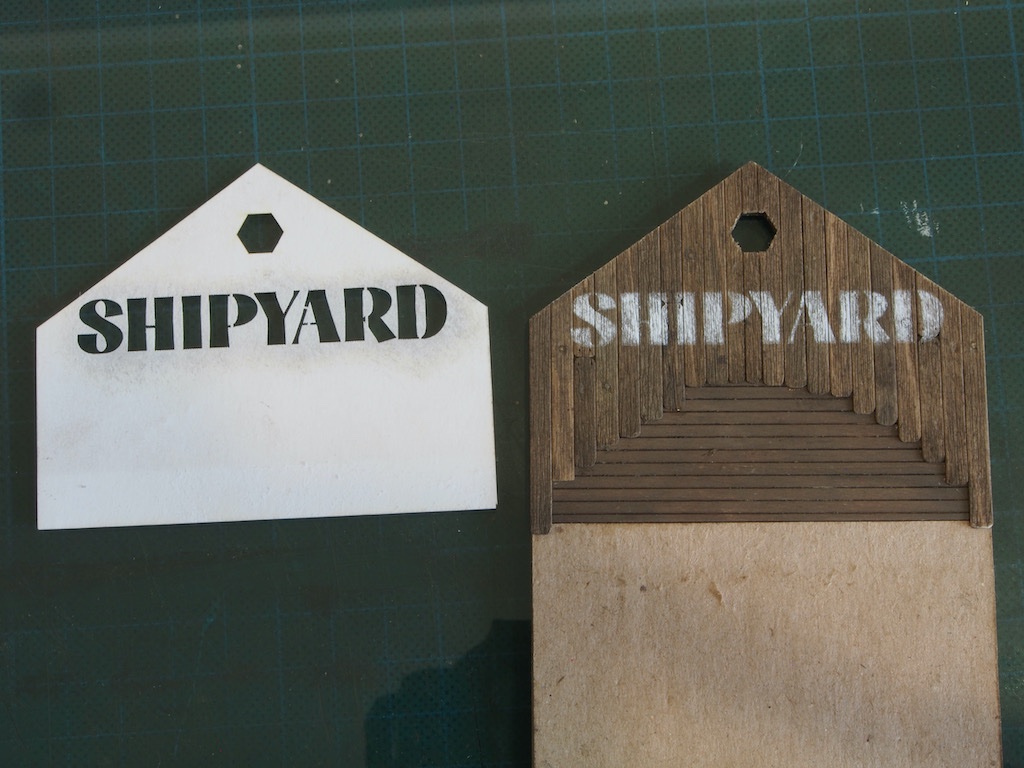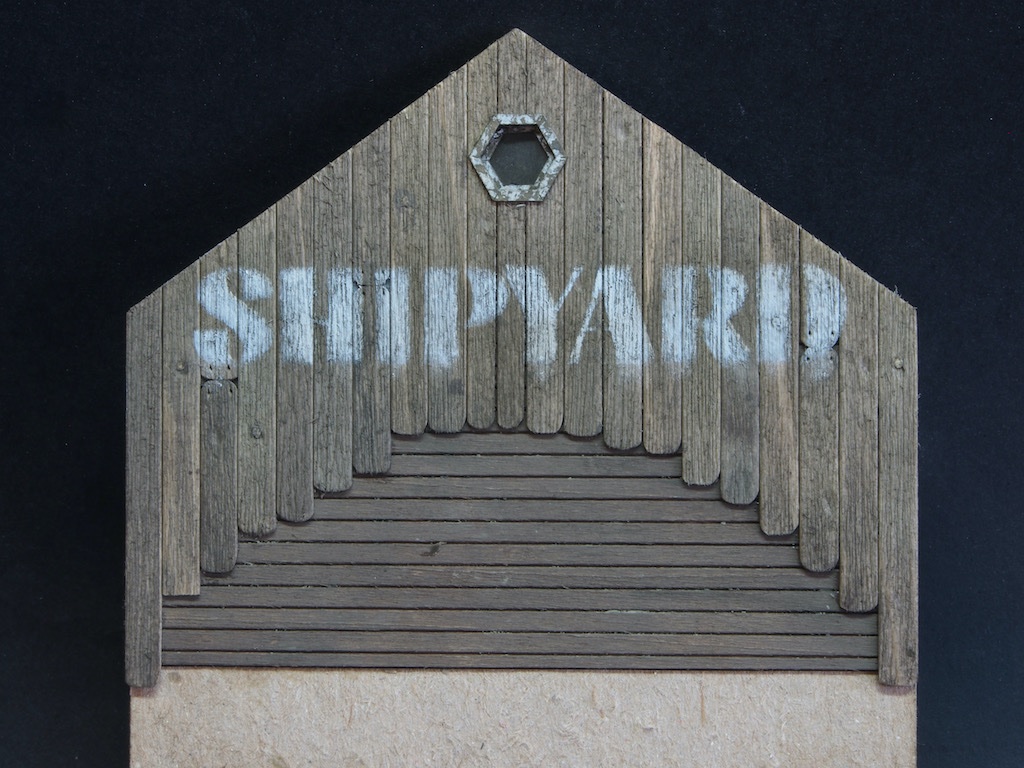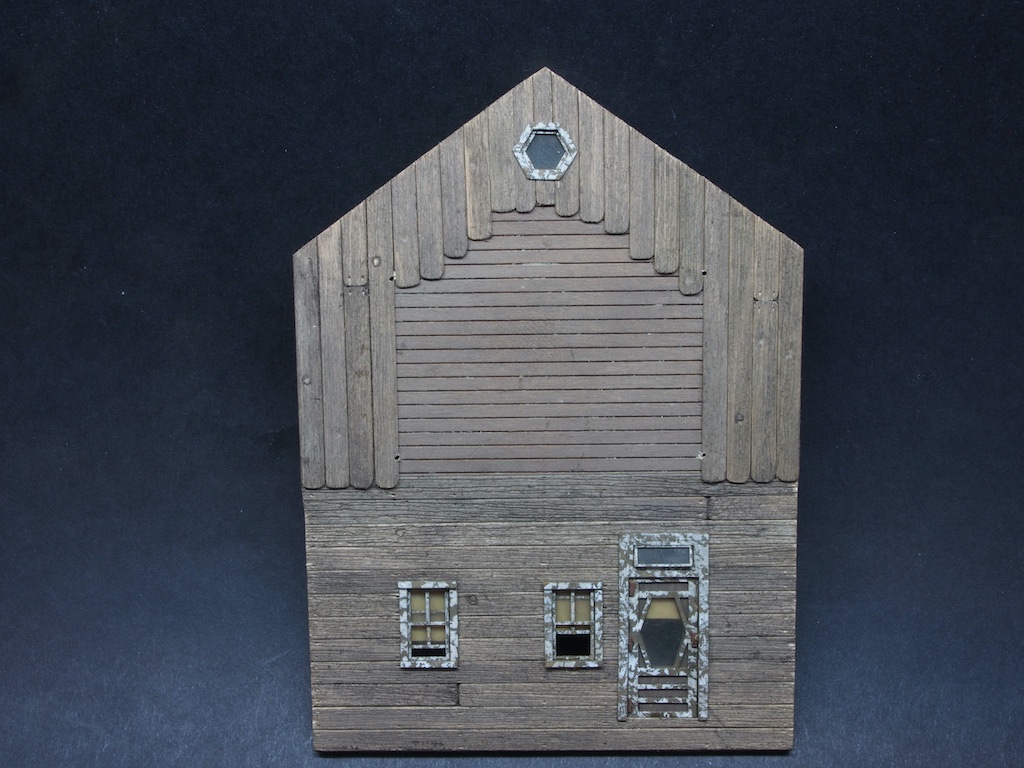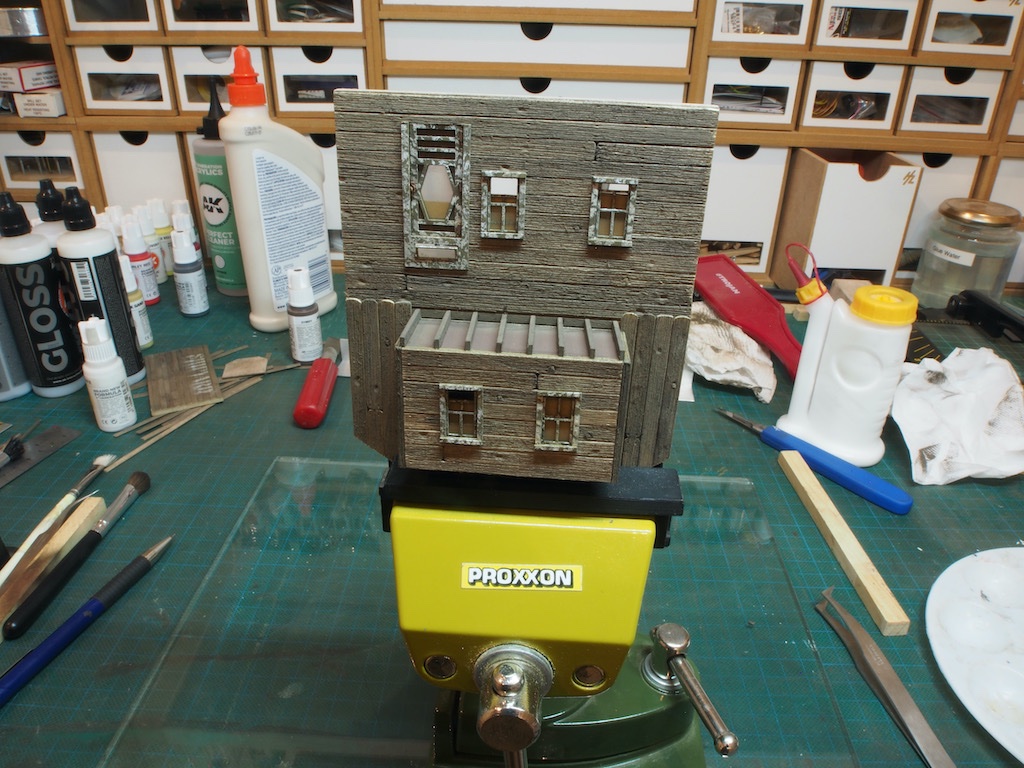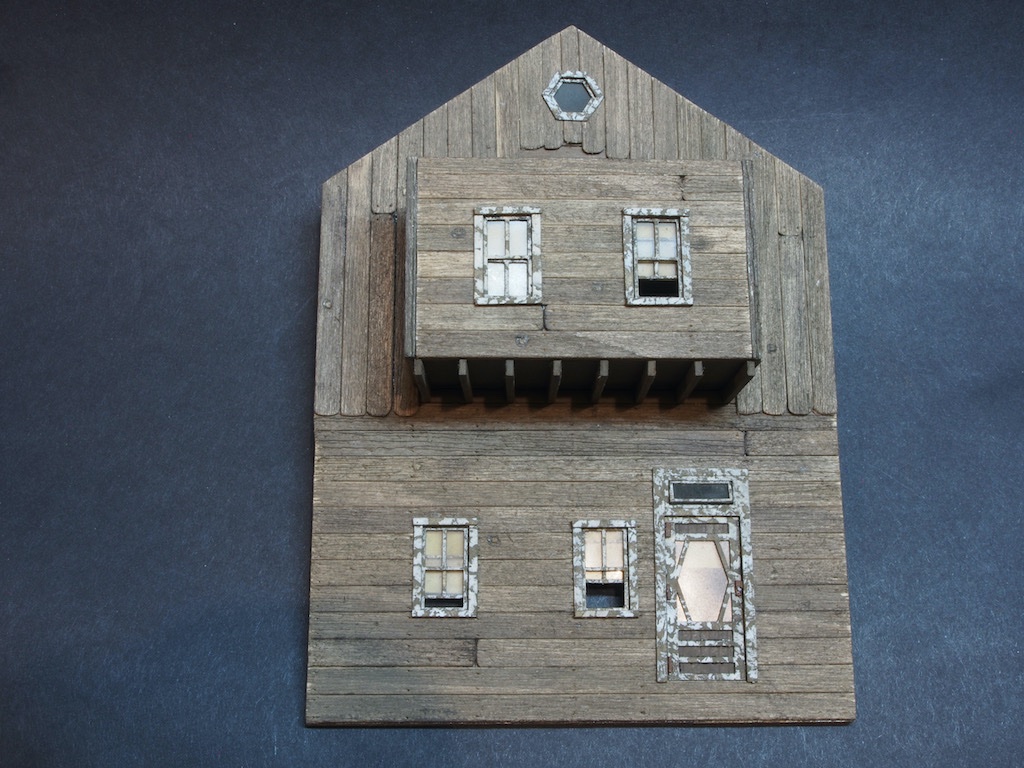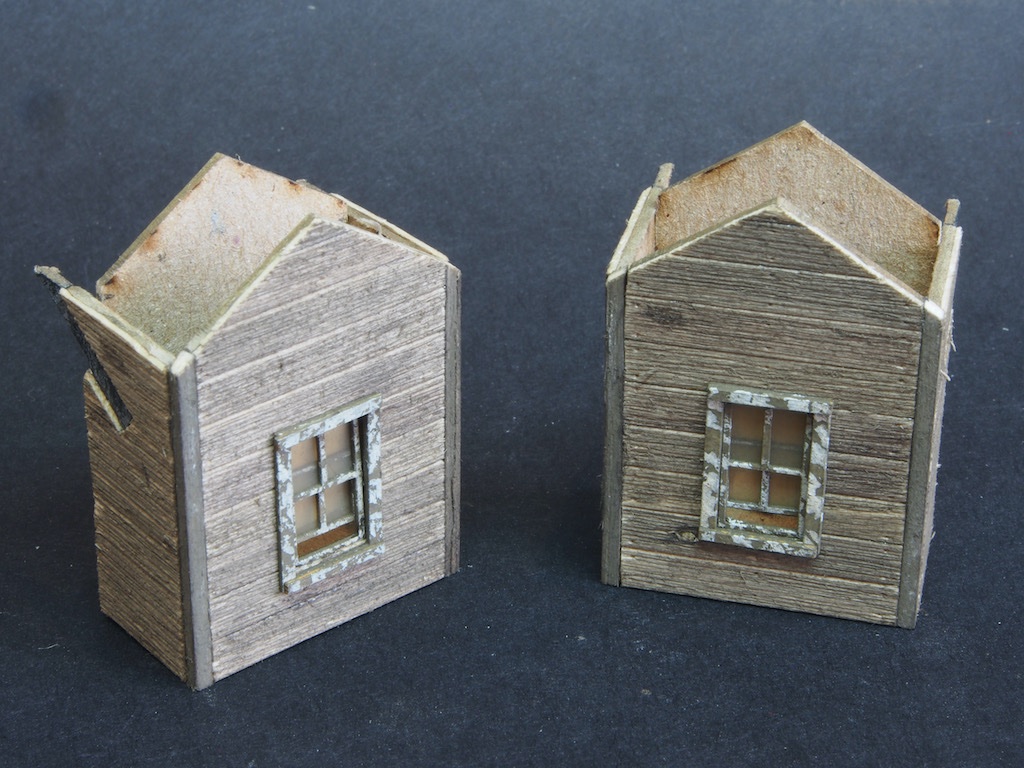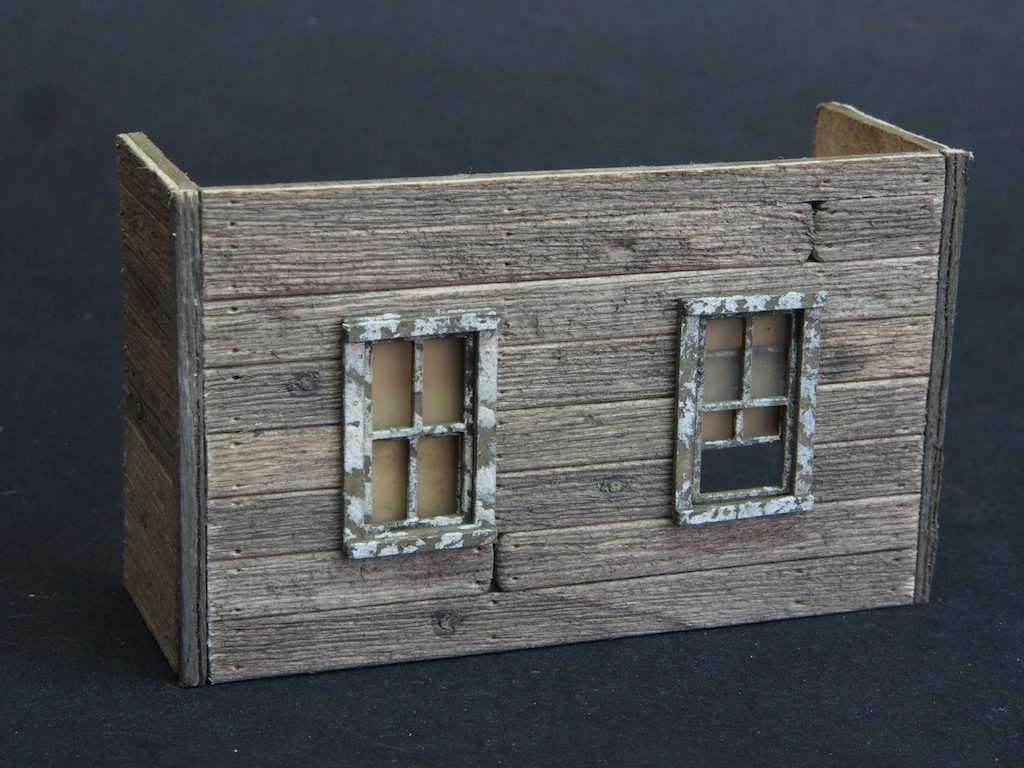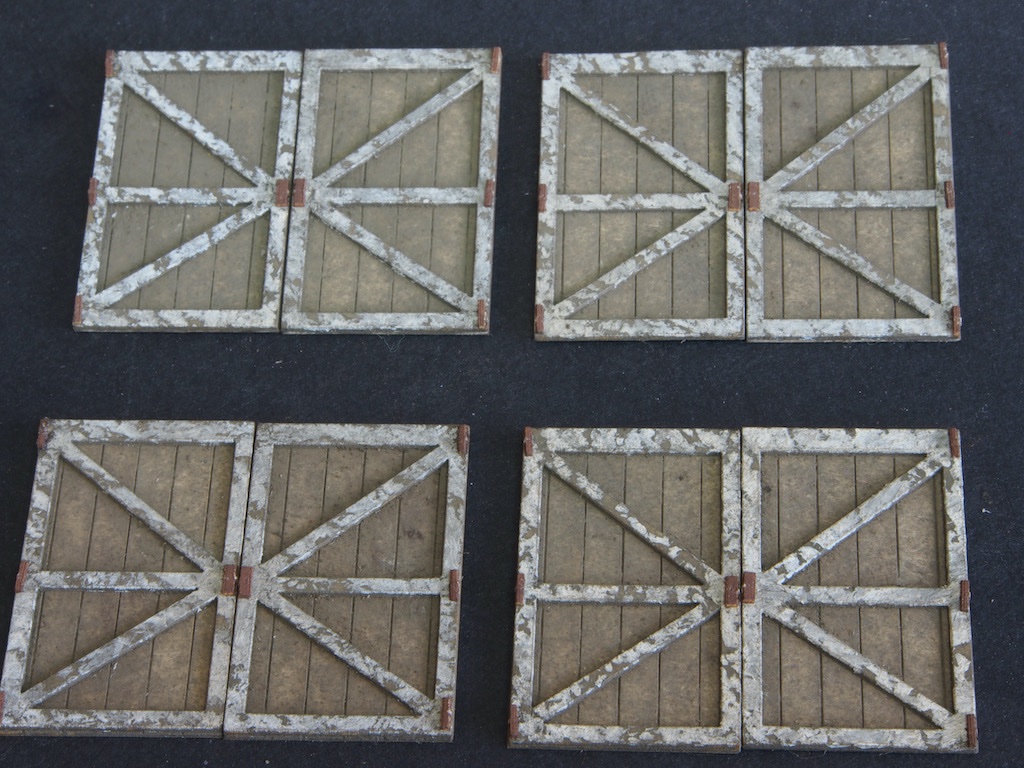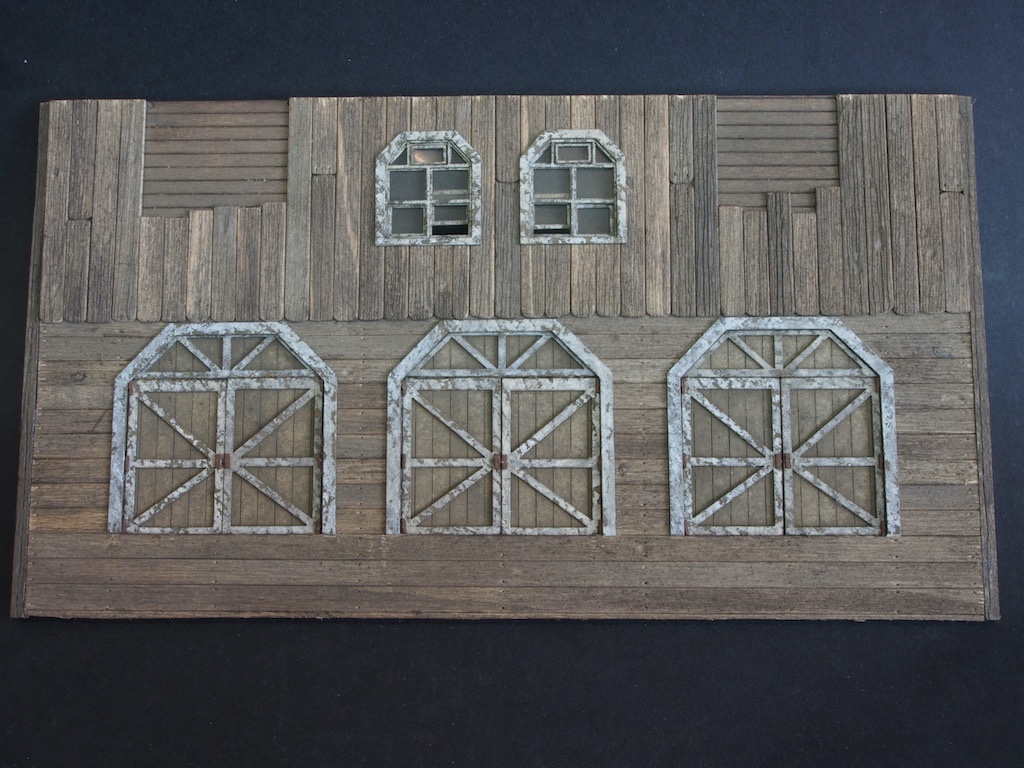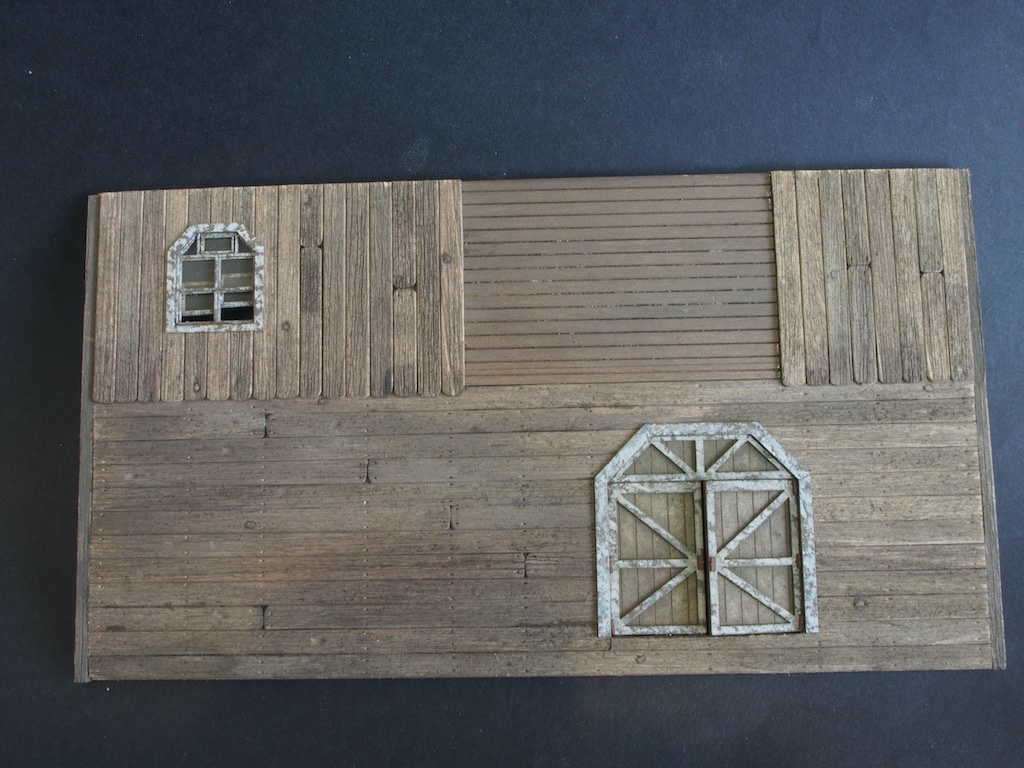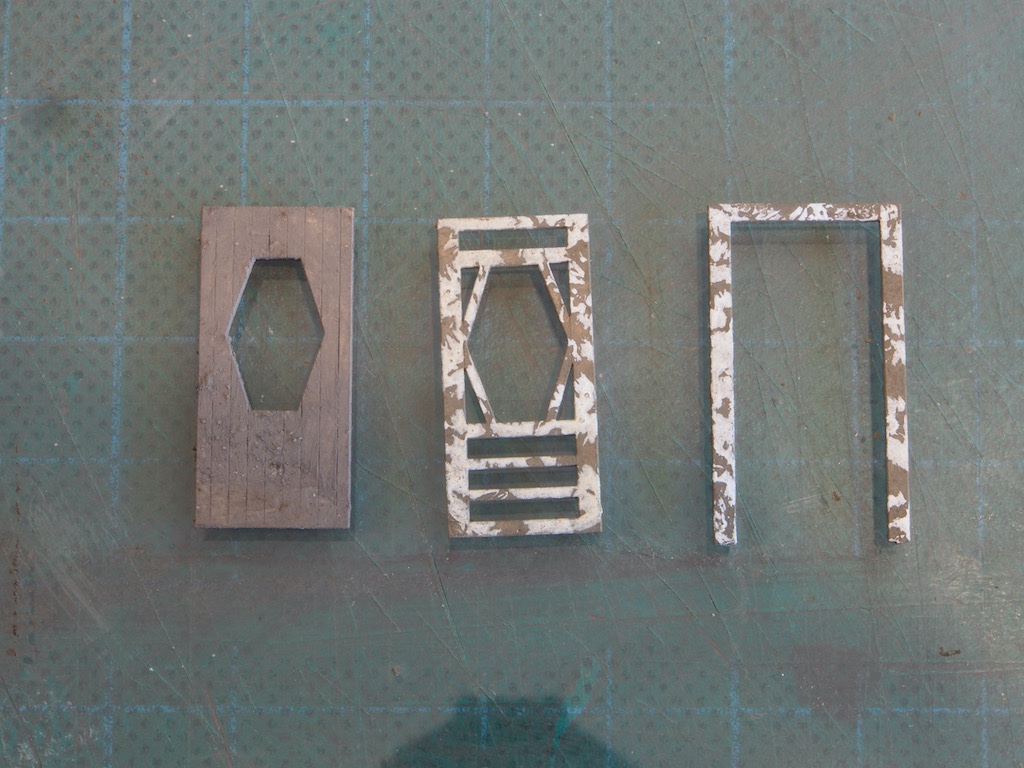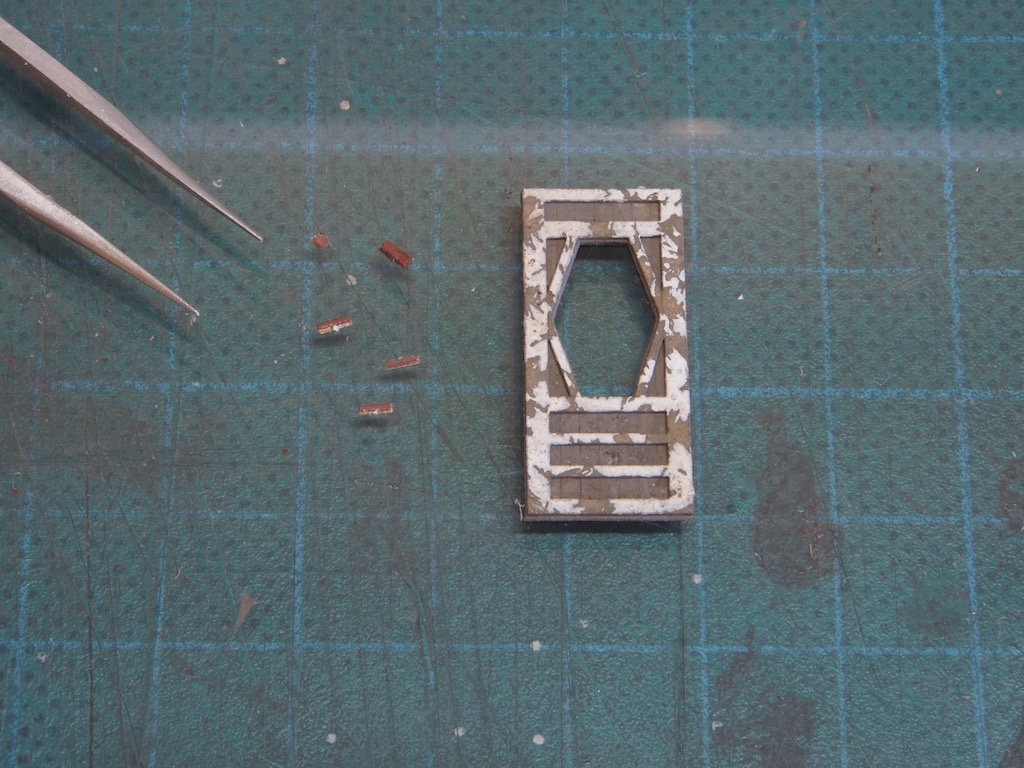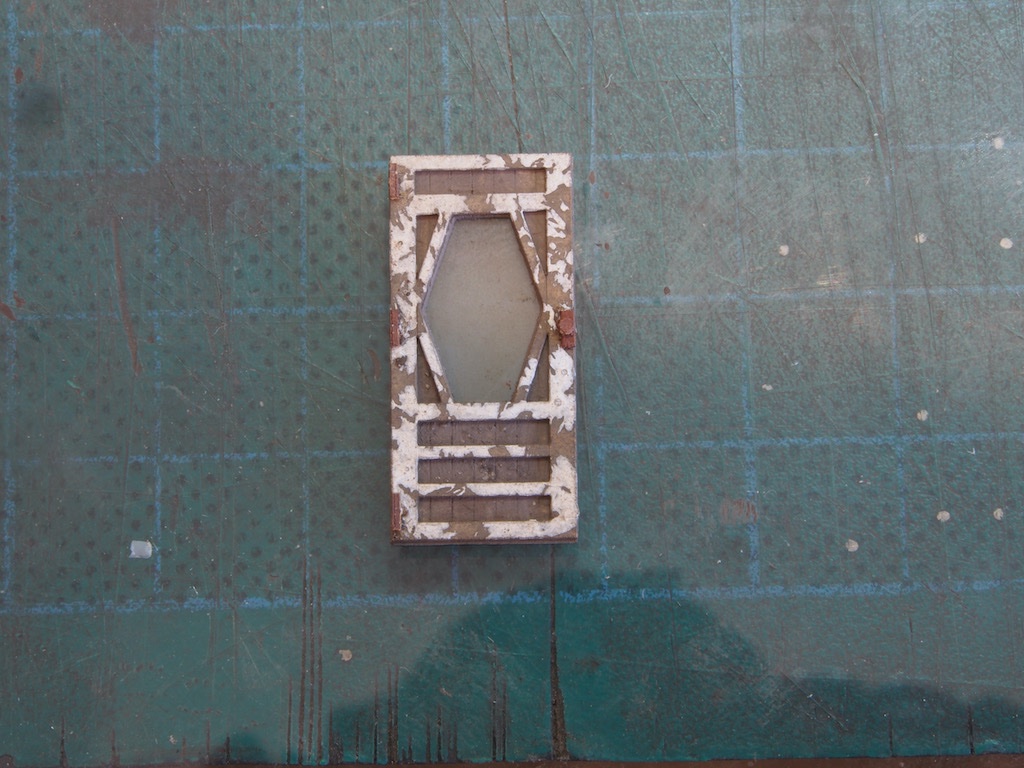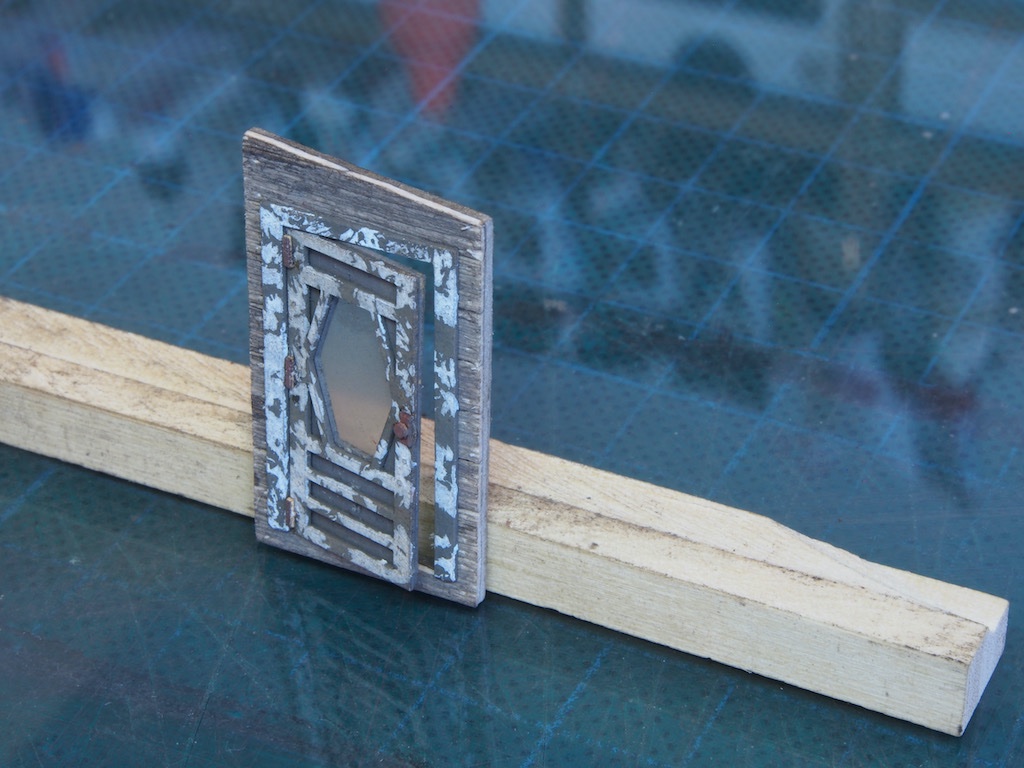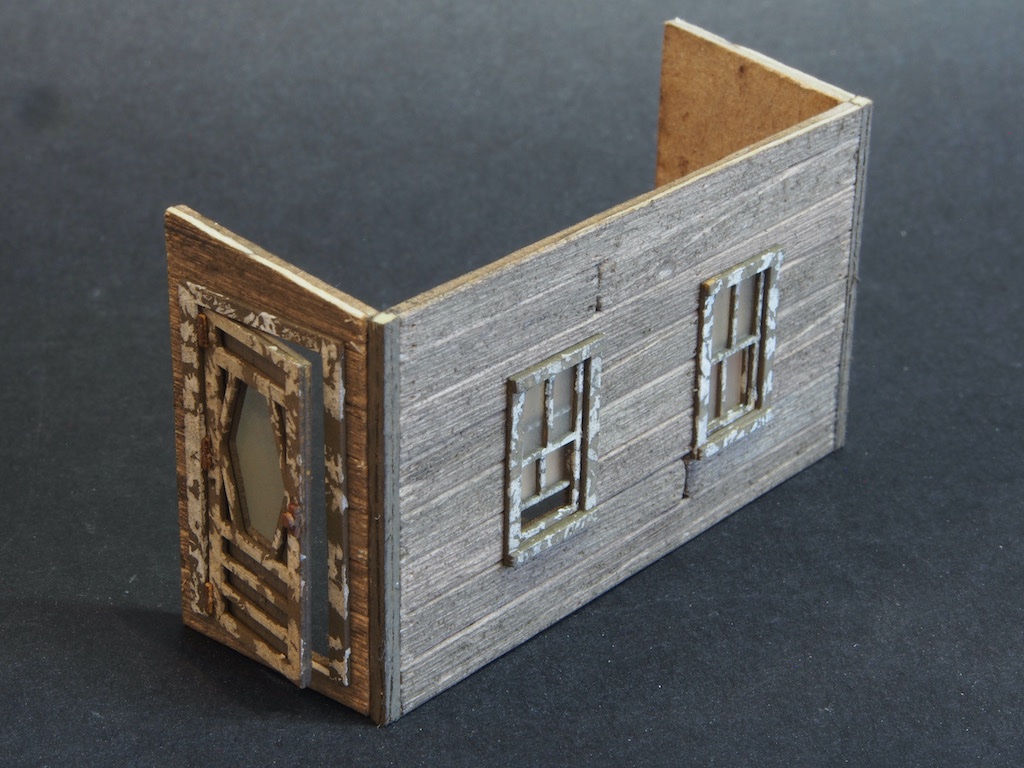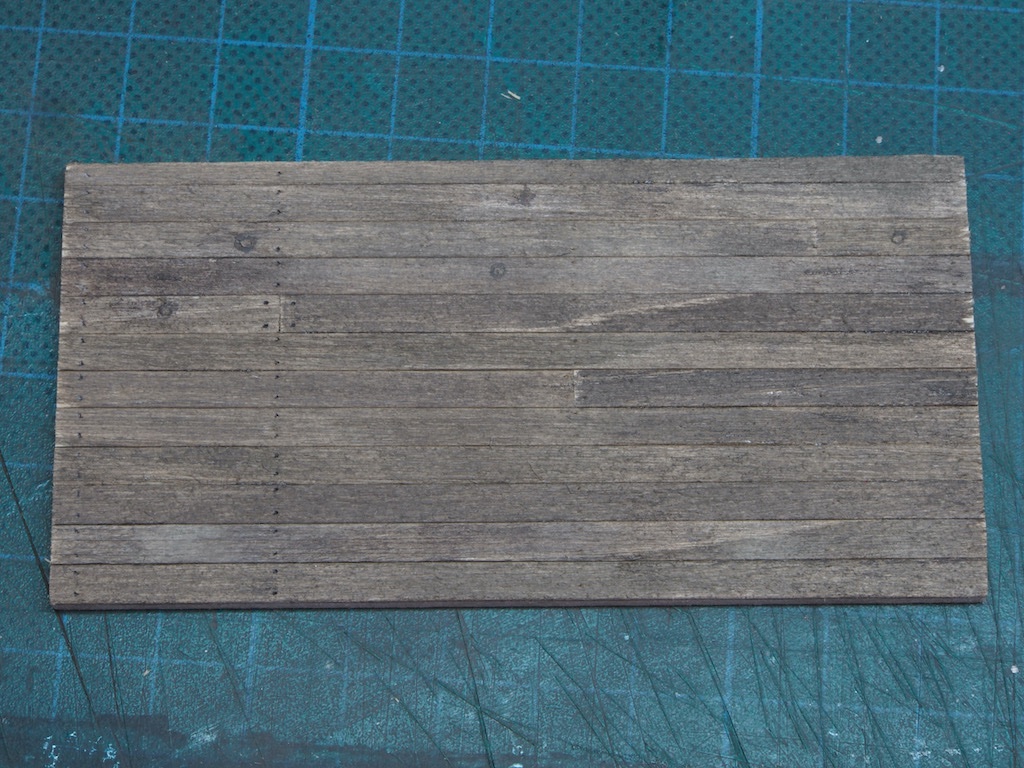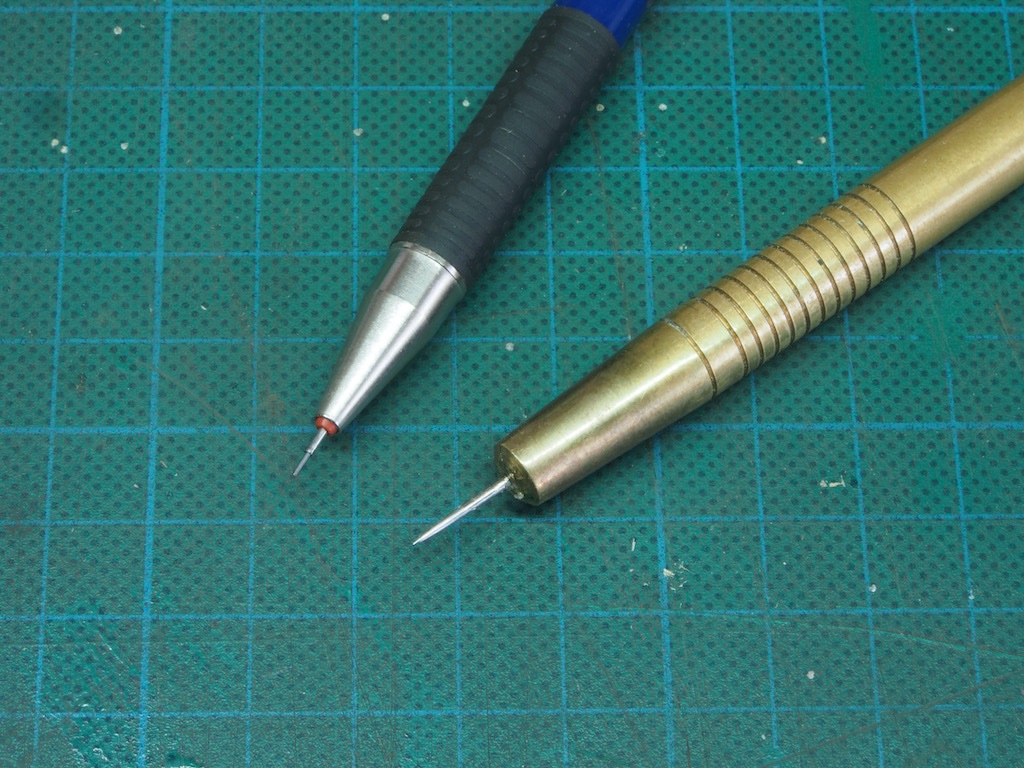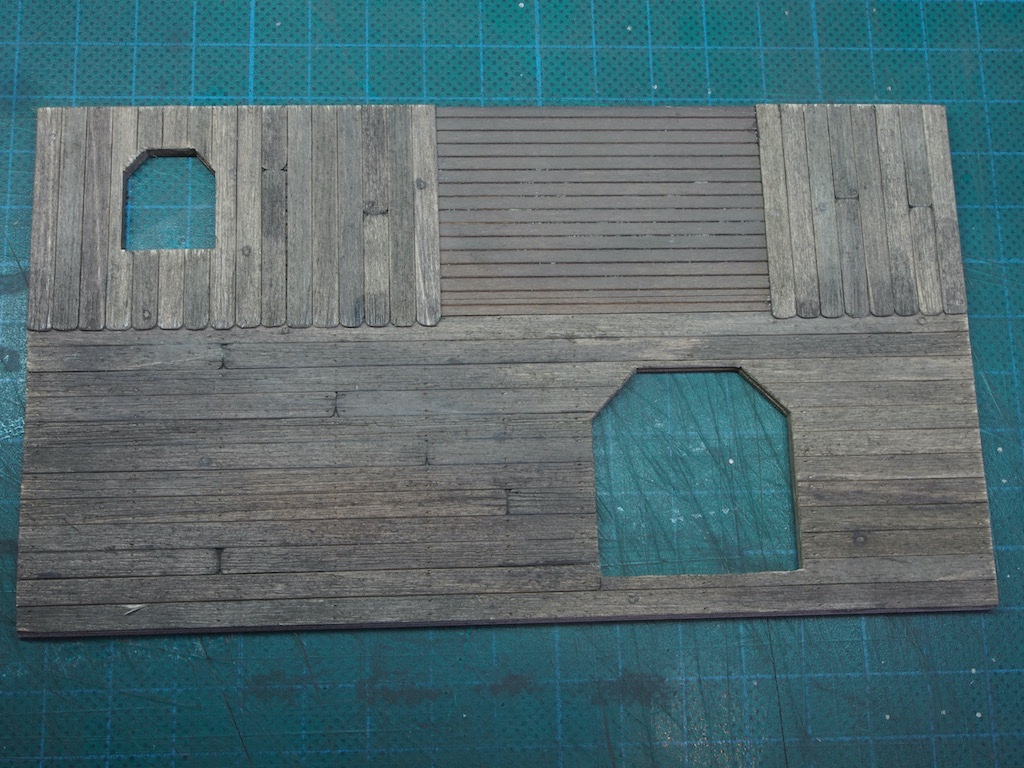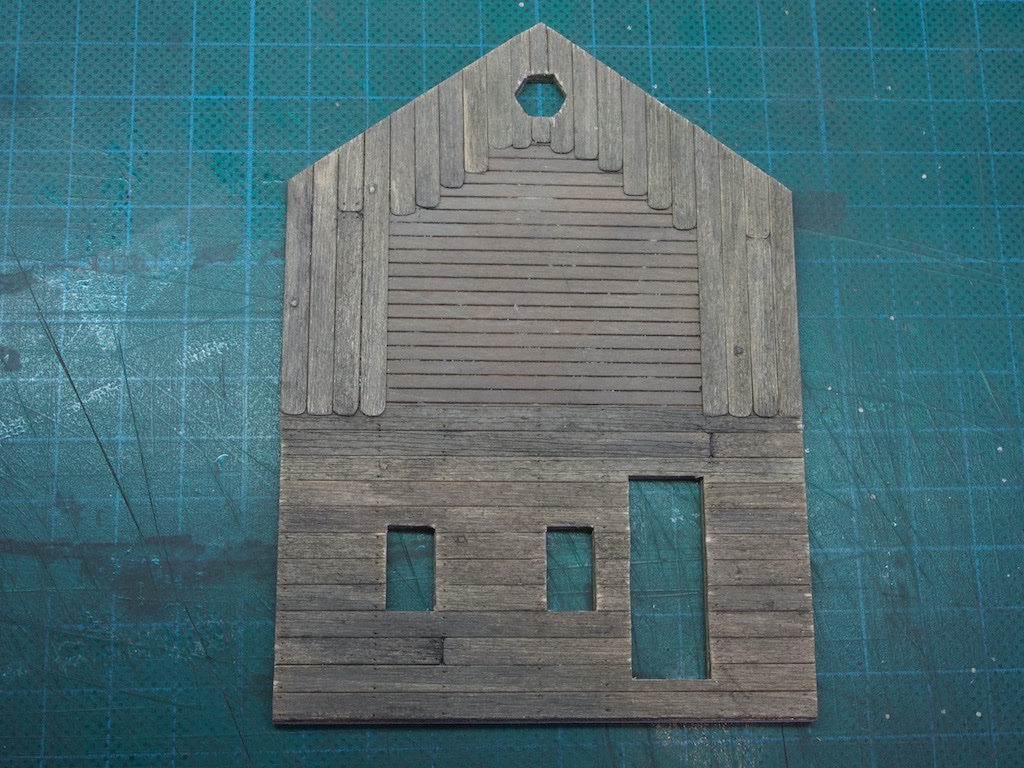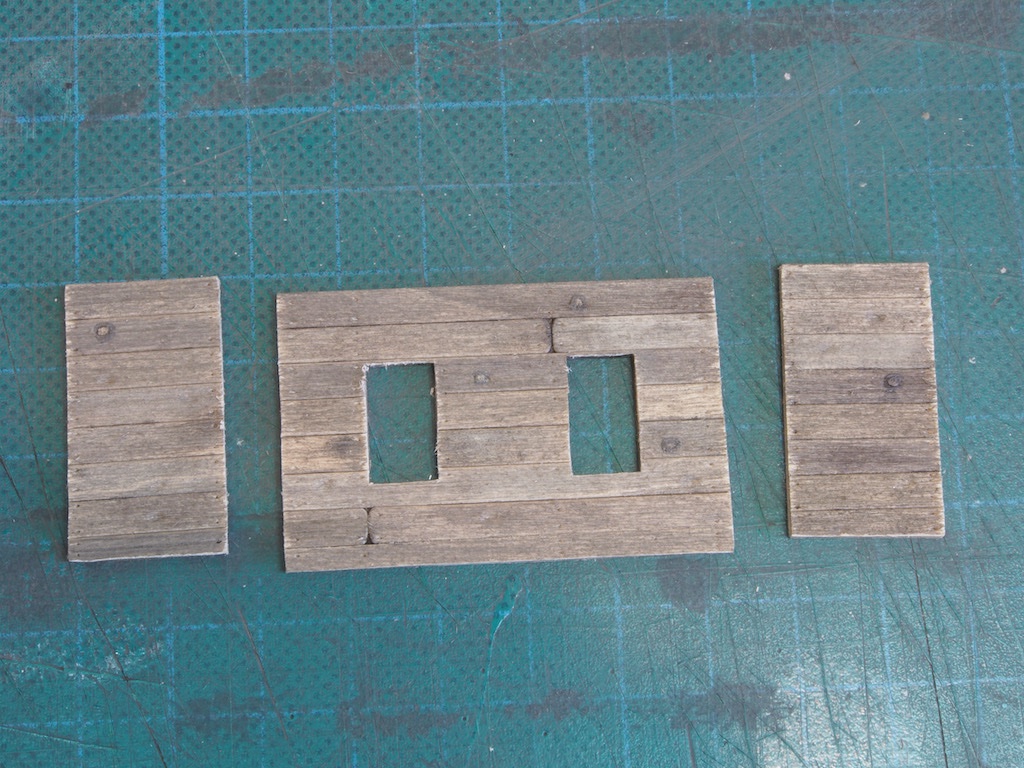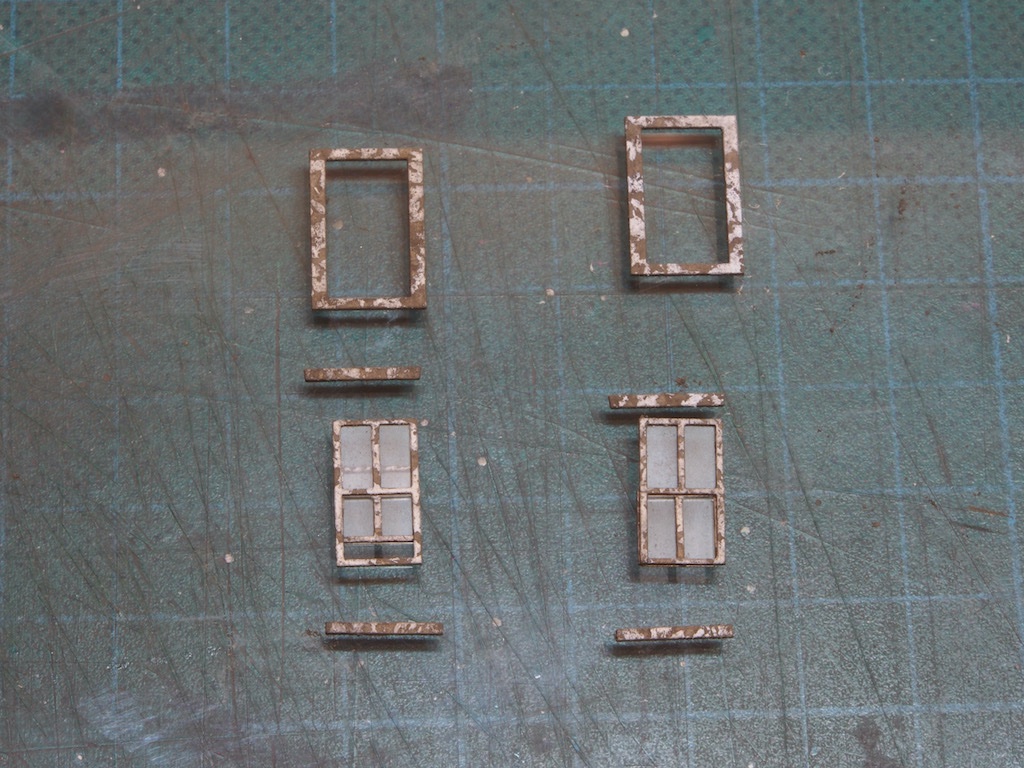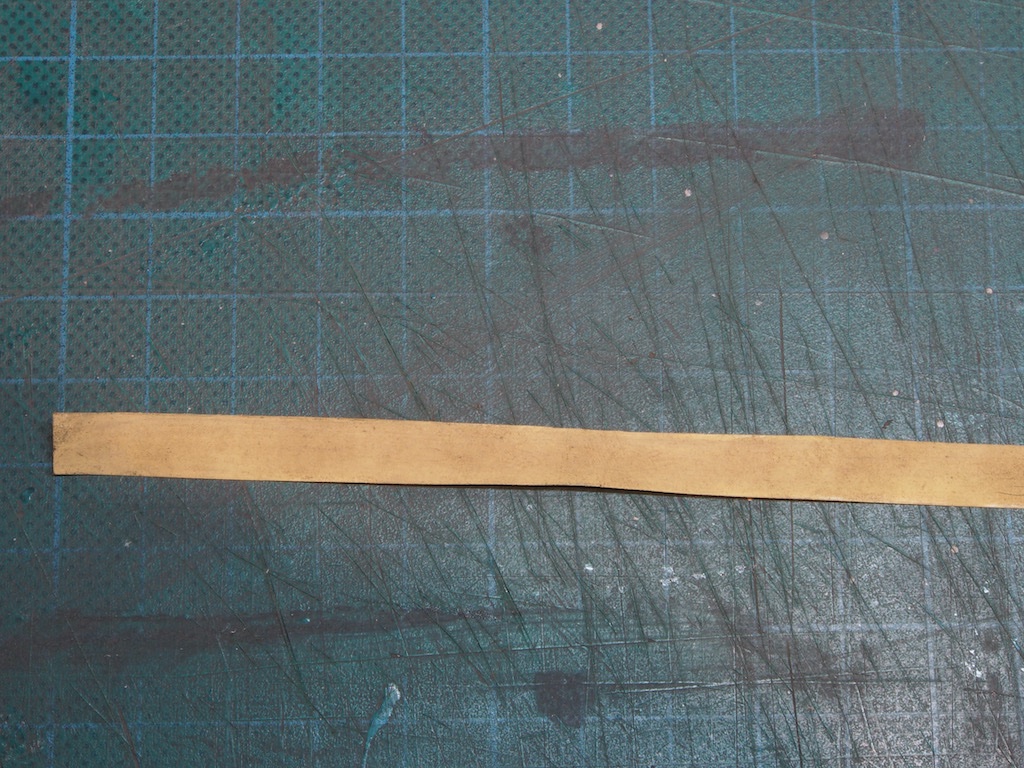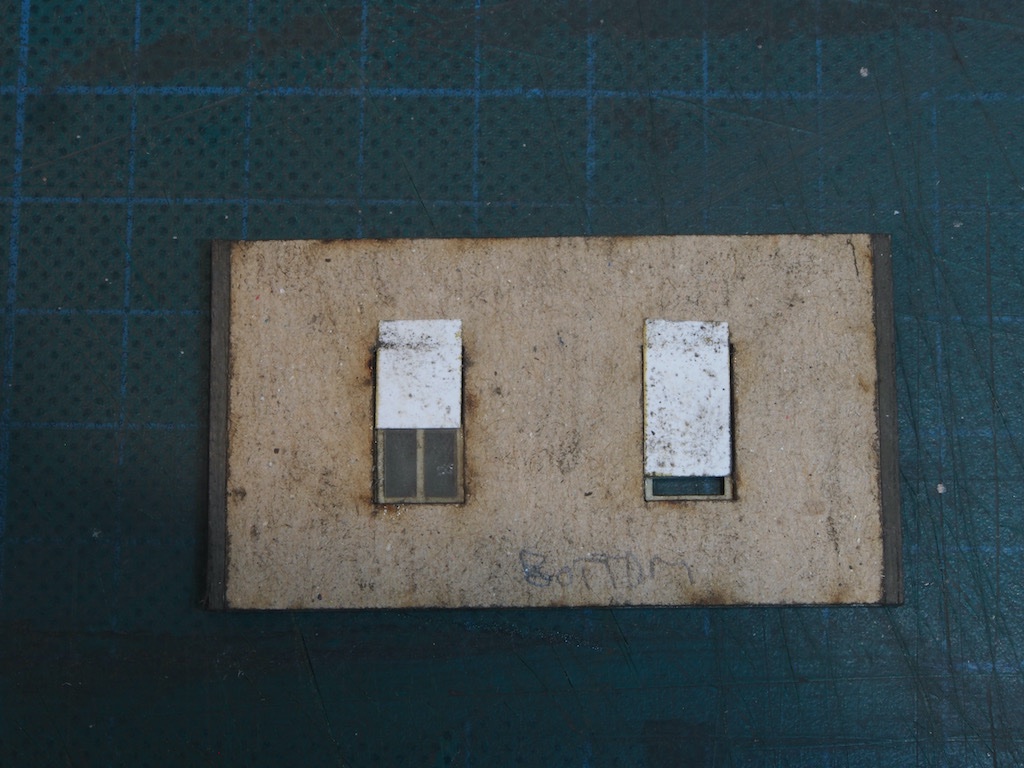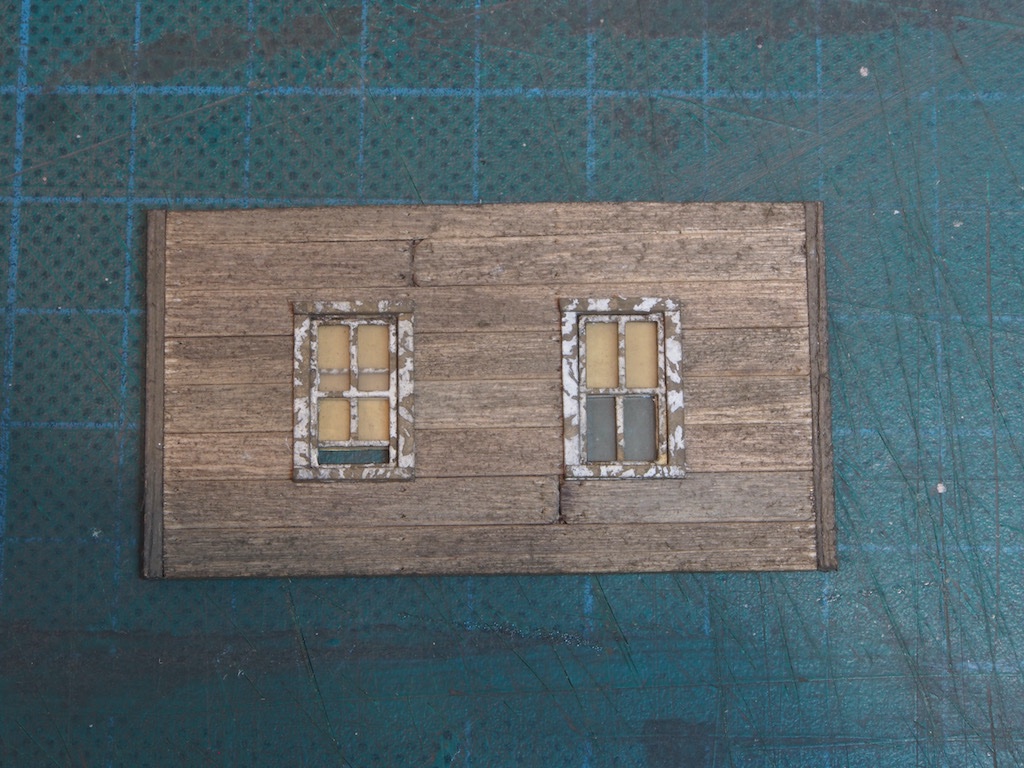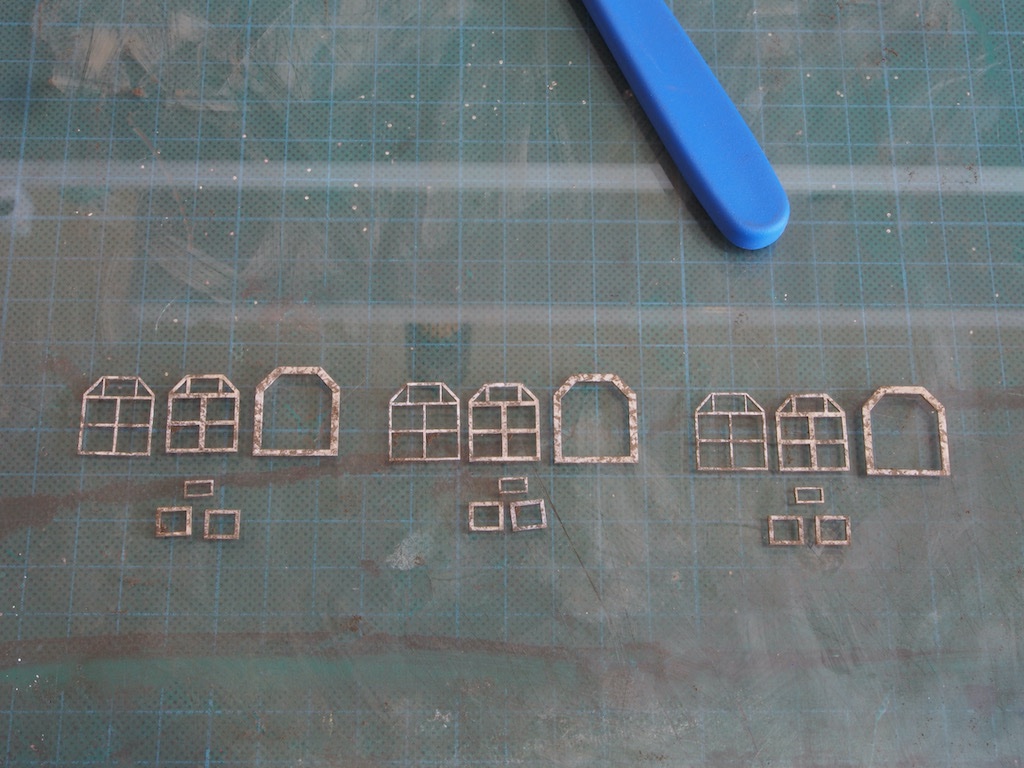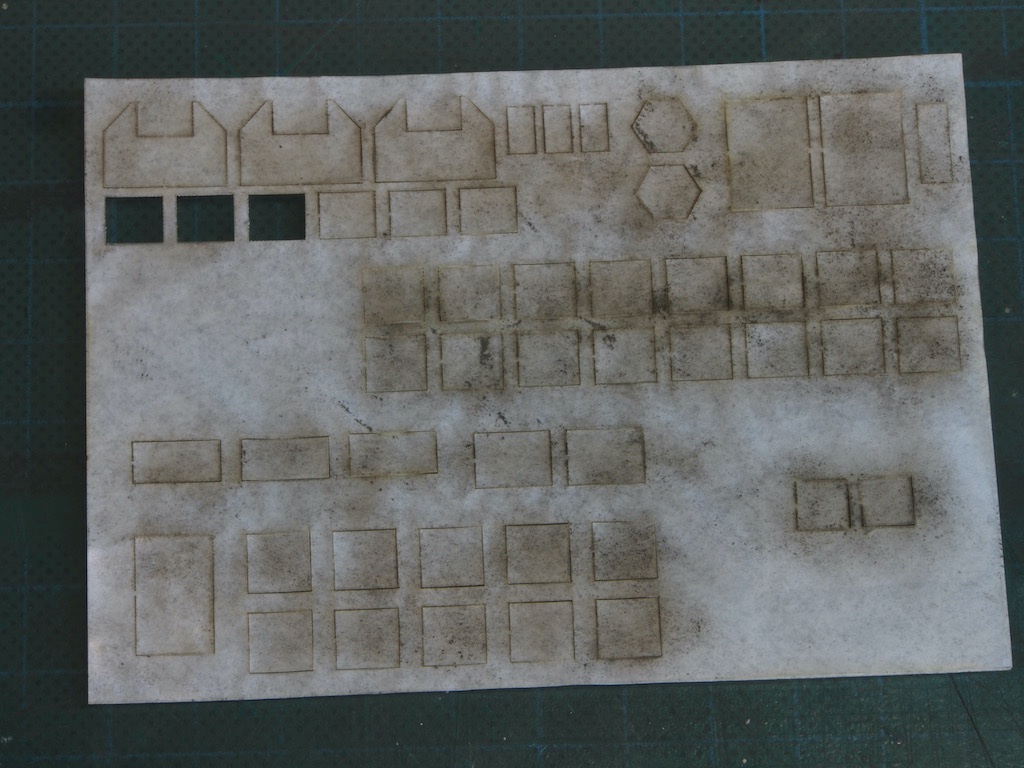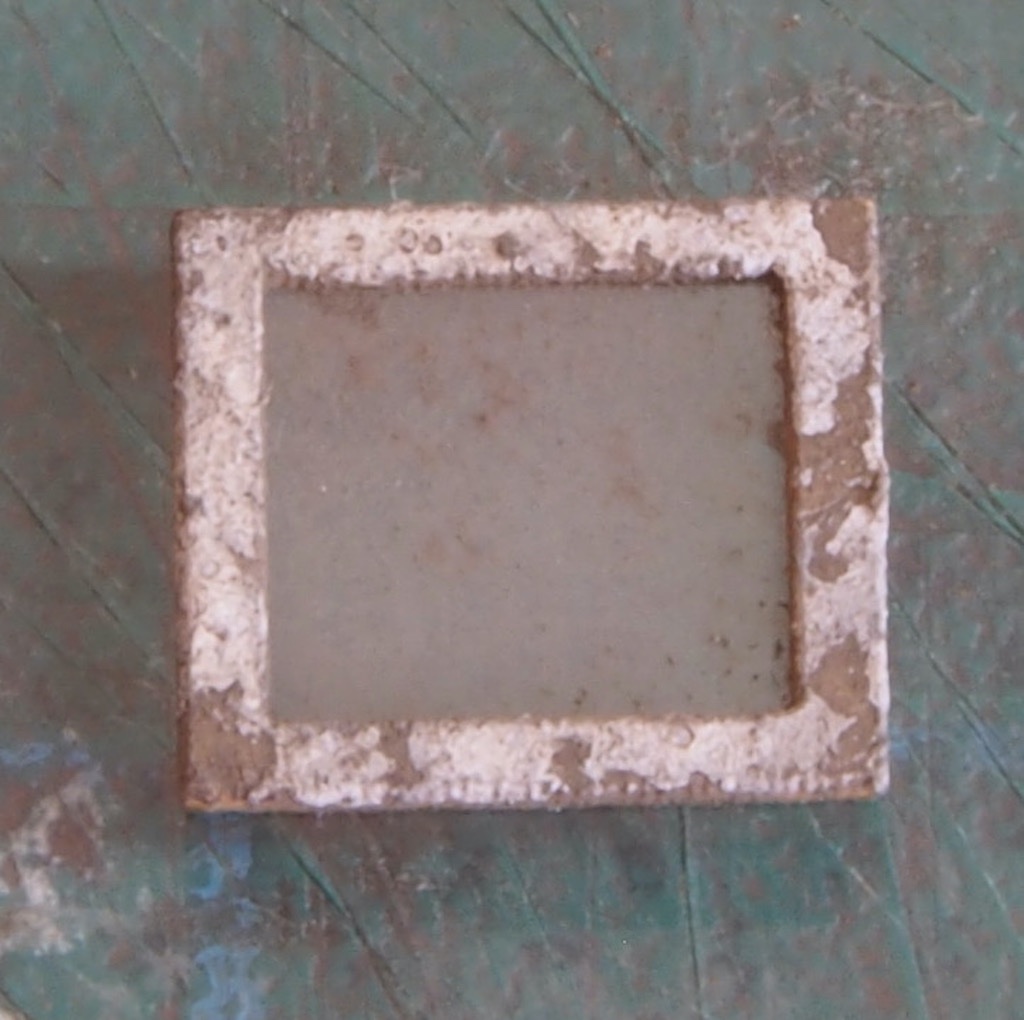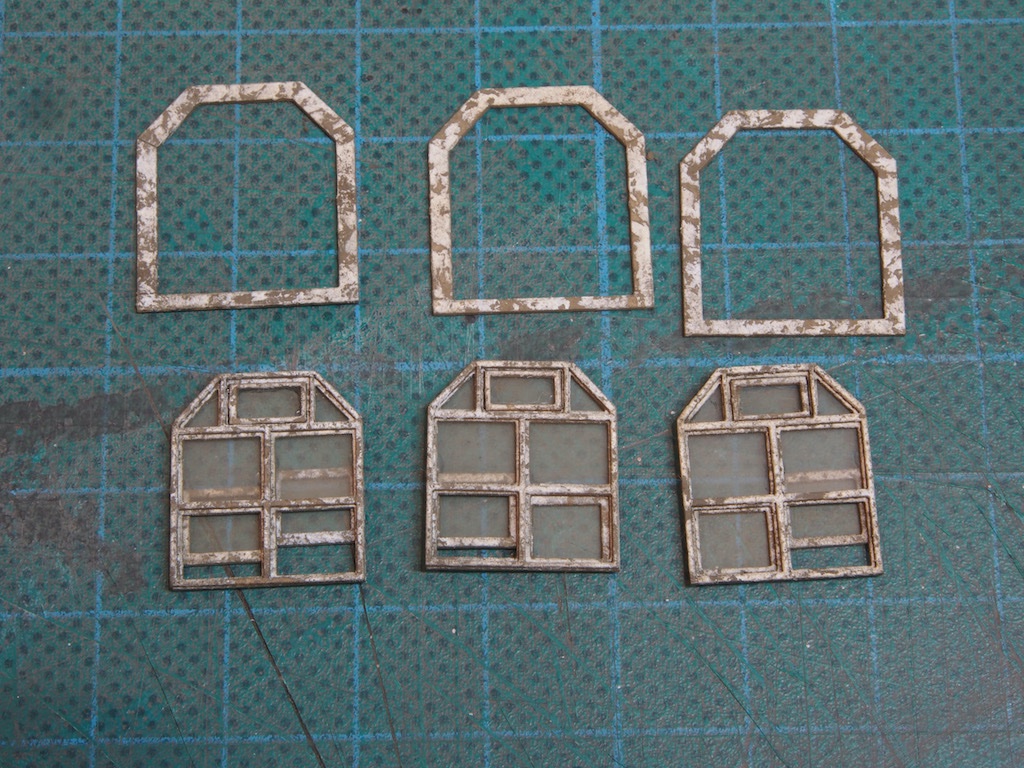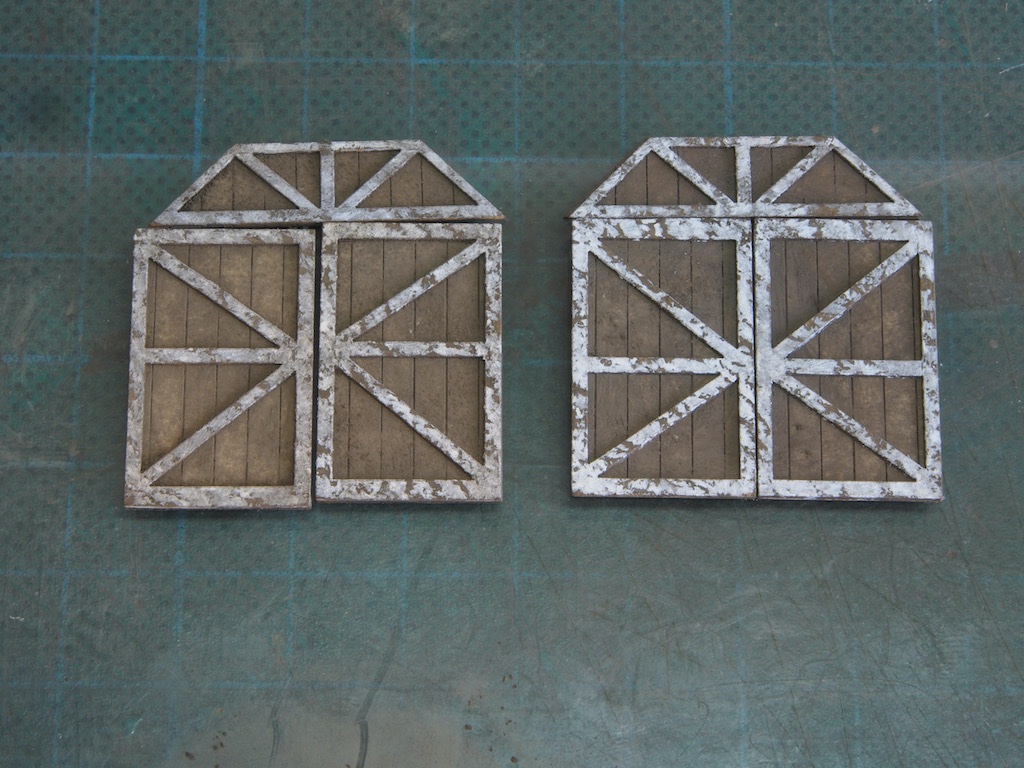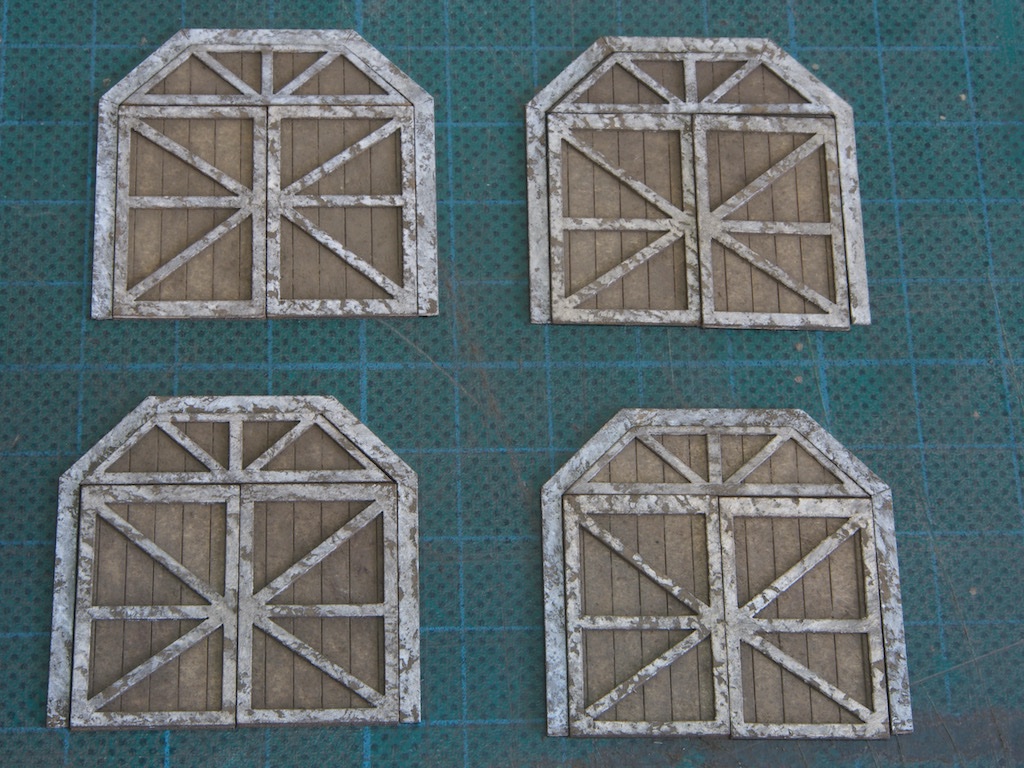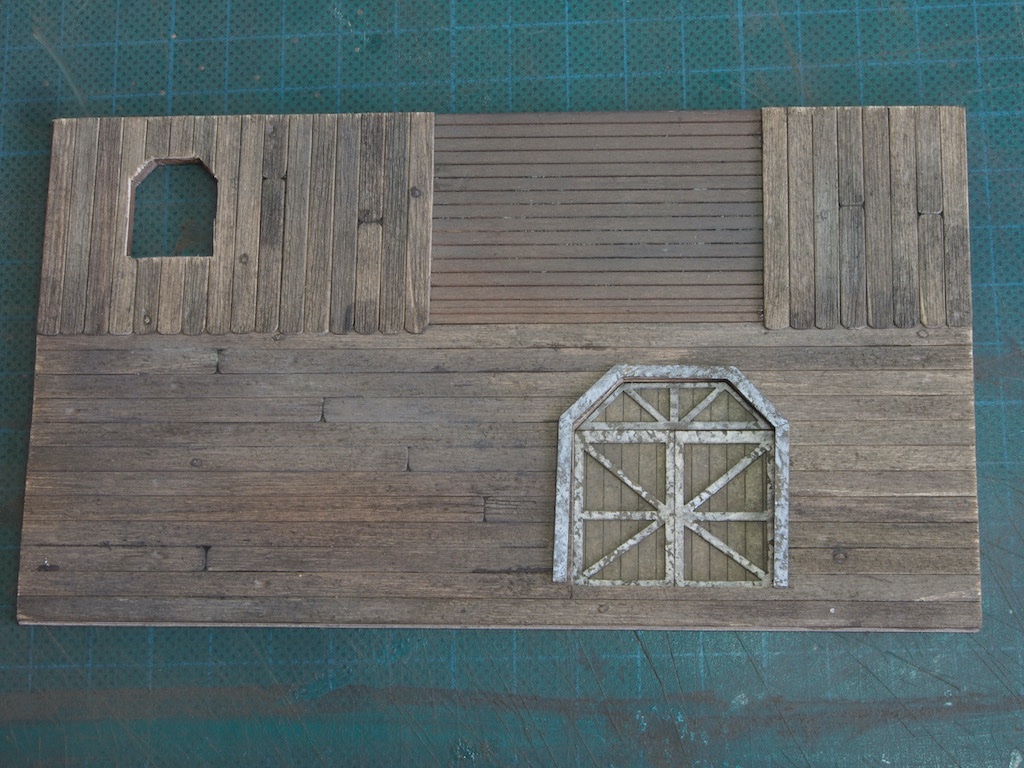-
Posts
4,891 -
Joined
-
Last visited
Content Type
Profiles
Forums
Gallery
Events
Everything posted by gjdale
-
Thanks very much Ken and Gary, and also to all of the likes. Gary - high praise indeed. If I end up with something half as good as your dioramas, I'll be well pleased! Wall Construction – Wall Details (Left Wall) Details for the Left Wall commence with attaching the Dormer to the wall and adding the floor joists under the Dormer. This is done in the same way as for the Rear Wall just completed. The next item to add is the Sawdust Collector. This is a cast metal item that was cleaned up with a combination of #11 blade, file and brass brush mounted in my Proxxon rotary tool. Here’s what it looks like after clean-up. It was then blackened using Jax Pewter Black and buffed with a felt wheel in the rotary tool. It was mounted to the wall with epoxy darkened with a little black paint to represent tar and pitch, allowing a small amount to ooze out around the joint. Once dry, a wooden brace was added between the Sawdust Collector and the wall. Next, the landing is constructed using the provided template. Rather than cutting directly onto the template, I used scraps of wood to set the length of a stop on my Chopper in order to ensure pieces were identical in length and cut square. Once cut, I placed some double-sided tape over the template and glued the parts together over the template, using a straight edge to ensure that it was square. Once dry, some nail holes were added and the piece removed from the template. The landing is then attached to the main wall and the Dormer door wall. Two braces are cut to length and angle using the template as a guide, and attached to the landing and the wall. That completes the Left Wall (for now). Here is an overview of this wall to date. Next, we move on to the Right Wall…
-
The WWI series was my favourite. You really should check it out Glen.
- 134 replies
-
- Captain Kidd
- bottle
-
(and 3 more)
Tagged with:
-
Looking forward to seeing an update Mark. Hope you make it through the doldrums okay.
- 505 replies
-
- vanguard models
- Sphinx
-
(and 1 more)
Tagged with:
-
This build is very aptly named - it will be a real “adventure” implementing your cunning plan Glen! Or to quote Blackadder, a plan so cunning you could pin a tail on it and call it a fox! Can’t wait to see this come together.
- 134 replies
-
- Captain Kidd
- bottle
-
(and 3 more)
Tagged with:
-
Wall Construction – Wall Details (cont’d) I had a little unexpected free time today, so took advantage of that to continue the build. The awnings are provided on a laser-cut sheet. We initially applied a base coat to this way back in “Advance Preparations”. It is now prepared in the same way as the tar paper, with coat of dull cote followed by some light streaking with chalk. The awnings were then cut free from the carrier sheet and folded along the score lines. A little extra chalk powder was applied to the creases after folding. I used Rembrandt 343.5 for this as it seemed to be a close match to the base coat. They were then glued in place – a delicate but relatively straight forward operation. The signs were then trimmed up and glued in place. That completes the Rear Wall. On to the Left Wall next…
-
Wall Construction – Wall Details (cont’d) The tar paper is then cut into 1/2” wide strips and then those strips are cut into 1.5” lengths, which are then randomly mixed up. A cardboard substrate is provided for the dormer roof. It is laser cut with the side pieces cut part way through. Laser etched lines aid with the placement of the tar paper and, later on, the rafters. The underside of the substrate is first painted with AK 11110 Leather Brown (my substitute for Floquil Roof Brown). The instructions are well laid out for placing these strips, except that for the third strip (ie the second row) a single piece is called for, and the maximum length specified of 1.5" is not long enough for this span. No big deal, I just added a second piece, being sure to offset the joins from the first row. Here are the strips in place and the roof attached. The capping pieces for the peaks are then fitted - a little tricky, but we got there - and some final weathering added. I'm considering adding some "flashing" along the joint with the wall, with a coloured glue mix as I've seen in some other logs. A special laser cut jig is provided for cutting the rafters to length, with the correct angle on the inboard end (where they attach to the walls). This is a really neat addition that should make cutting the rafters fool-proof. I don't know why, but somewhere along the way I must have made an error in the placement of my roof, as all of my rafters were considerably too long. I ended up adjusting their lengths individually prior to final placement and the end result seems to be okay. I still have no idea where I went wrong. And finally, here is an overview of the wall at this stage. I still have to add the awnings and place the signs before completing this wall.
-
It's been a few weeks since I updated this log. A week away on holiday followed by a week of life getting in the way has slowed me down a little, but I finally got back to this today. A small update, but progress nevertheless... Wall Construction – Wall Details (cont’d) The signs turned out to be not as tricky as I first thought. The signs are provided on ordinary paper and several copies are provided, allowing you freedom to experiment without fear of unrecoverable errors. The first task is to dirty them up using some dry chalk powder and then sand the back of the paper down as far as possible without ripping it. The trick is stopping just short of that point, and not just after it! Bases for the signs are made by preparing some strip wood in the same way as the walls, and then cutting the appropriate number to length using a provided template. The base boards are then lightly tack-glued together and the sign is then glued to the base. Once dry, the boards are cut apart by carefully bending them back to create a small gap and then inserting a single edge razor blade into that gap and pressing down onto the table until it cuts right through. Once all the boards are cut apart, they are then glued back together. This allows the detail of the individual boards to be visible. Here is the end result – just placed on the wall for context for now. Preparations for the dormer roofs now begin by returning to the tar paper pieces prepared way back in “Advance Preparations”. The painted tar paper is firstly sprayed lightly with Dull Cote (I used an artist matt picture finish). After allowing it to dry for a few minutes, a little white and grey chalk powder are then sprinkled randomly over the tar paper. A soft brush is then used to apply alcohol, brushing in an up and down motion only, to create some streaking. The alcohol reacts with the matt finish and replicates the effects of the sun bleaching out the red colour. I wasn’t happy with my first go at this and ended up re-spraying the tar paper with paint and repeating the whole process again. Here is how they look as of today. These will now be cut into strips before being applied to the dormer roof. Stay tuned…
-
Fabulous Glen - the rust looks just right.
- 134 replies
-
- Captain Kidd
- bottle
-
(and 3 more)
Tagged with:
-
This is so cool Ian! Perhaps Glen (McGuire) can make you some miniature slaves to man the oars in the final rendition!
- 536 replies
-
- Quadrireme
- radio
-
(and 1 more)
Tagged with:
-
I somehow missed the start of this project (again!), Glen - but I’m in for the ride now. Glad you found some of the weathering techniques from the Shipyard to be helpful. I’d love to take credit for that, but sadly I was only following someone else’s instructions! On that note, you really should try the “chalk and alcohol” method for colouring your weathered timbers - it’s dead easy, super quick, and produces great results. Your progress so far is great. I’m looking forward to following along for the rest of the journey.
- 134 replies
-
- Captain Kidd
- bottle
-
(and 3 more)
Tagged with:
-
This is just fascinating to watch Ian. 😊 I’m looking forward to the day you put this in an actual hull on the water.
- 536 replies
-
- Quadrireme
- radio
-
(and 1 more)
Tagged with:
-
Congratulations on completing yet another masterpiece B.E. 👏👏👏
- 857 replies
-
- Sphinx
- Vanguard Models
-
(and 1 more)
Tagged with:
-
Congratulations on completing a real masterpiece Chuck. As others have said, inspirational.
- 1,784 replies
-
- winchelsea
- Syren Ship Model Company
-
(and 1 more)
Tagged with:
-
Wall Construction – Wall Details (cont’d) This next job is to apply a stencilled sign to the Front Wall. Although a stencil is provided for this, I was still dreading this particular task. In the end, it turned out a lot easier than I’d expected. The stencil provided is also shaped to match the wall, so alignment is guaranteed. Nevertheless, I did a practice run on my “crash test dummy” wall first and once I was happy with the techniques, I dove right in. Here is the result after the application of the paint (the first step in the process). The paint is then toned down a little with a dusting of chalk (in the same way as the windows were treated). The instructions then direct us to “use a small detailing brush to streak a little white chalk powder down the lettering and face of the wall”. I was quite nervous about this step, so back to my test wall for practice. I was glad I took this step because my first attempt was waaaay too much white chalk. With that as a gauge, I tackled the real thing and was fairly satisfied with the result. The instructions emphasise that “less is more here”. Here is the end result, complete with attic window fitted. We now return to the Rear Wall and start by making up and installing the windows and doors. As this process is exactly the same as previously described, I won’t repeat the details here - except to note that the transom window on the door has been left ajar just for Glen...😉 We now get to install the Dormer on this wall. Another clever design feature of this kit is the inclusion of some very small laser cut holes in the substrate that are used to align the Dormers. We are invited to punch through these holes and through the applied siding with a sharp object. I opted to use a small drill to avoid the risk of splitting the siding. I also decided to attach a piece of scrap wood along where the bottom of the Dormer will sit to avoid having a gap here (since the Dormer will sit on the siding along it’s sides). With the Dormer safely installed, it's time to add the floor joists for the Dormer. The kit provides a paper template and gives instructions for using this to create the Floor Joists. I opted to use the template to mark a scrap of wood and then cut this and checked it against the template again before using it to set a stop on my Chopper. That quickly gave me the eight required joists of identical length and all with perfectly square ends. I used the soft jaws of my Proxxon vice to hold the wall upside down while I attached the joists. In this photo, you also get a glimpse of just how messy my modelling desk is at the moment! And here is the wall at the close of play today (minus the background clutter). Another terrifying task awaits me tomorrow when I will tackle the Signs…
-
That’s exactly right Glen. In the manual they are referred to as “pop-out” windows. An option when installing them is to position one or more of them partially open. I opted not to at the time, but kinda wish I had now. To go back and try to change that would be too high a risk of damaging things though, so they’ll have to stay closed.
-
Thanks Ken - I suppose you could brace the corners, but it doesn't appear to be necessary with the design of this kit. The floor pieces, and later the roof pieces, will provide all the bracing required. Wall Construction – More Details The next step is to add trim to the ends of the remaining Dormer walls, as well as windows, before joining the walls together and adding floors. Here are the two Right Wall Dormers completed – these have a rear wall added as well. These macro shots also show the nail hole details quite well. And here is the Rear Wall Dormer. Our attention then returns to the main walls, starting with adding Hinges and Handles to the previously prepared Freight Doors. The previously prepared Main windows and their frames are then attached to the walls. To insert the Freight Doors, a template piece is provided that inserts in the openings and enables the Freight Doors to be recessed just the right amount. Once the doors are glued in place, the frames are added on the outside. Here is the Right Main Wall, with the three freight doors and windows installed. And here is the Left Main Wall. On this wall, I opted to leave the Freight Door slightly ajar for added interest. The End Walls are next….
-
Thanks Glen, Sam and Egilman, and again to all of the likes. Moving right along... Wall Construction – Dormer Details (cont’d) This Dormer has a door that will open onto a landing atop a set of stairs. We begin by giving the door pieces all the same “peeling paint” treatment as the windows. The hinges, door knob plate and door knob all get a coat of paint (AK11110, Leather Brown in lieu of Floquil Roof Brown). We are then instructed to “dust a little rust chalk powder on them”. The instructions don’t mention the exact colour for the rust, but earlier in my Sierra West log, a couple of the “gurus” had mentioned that Rembrandt 411.3 was their “go to” rust colour, so I went with that. Here they are with the points of my tweezers for scale reference. These things are tiny! And here they are attached to the door, with the mylar window glass also in place. The door is then glued to the wall and the outer frame attached. I followed a suggestion in the instructions and left the door slightly ajar. The three walls are then glued together, taking care to keep them level and square to each other. The next step is to fit both a floor and roof piece inside the wall structure, which will give the whole thing much greater stability. However, I have encountered an issue that I have sought some extra guidance on before committing to this step. I’ll update here once I’ve resolved that one.
-
Thanks very much Ken and Sam, and also to all of the "likes". Wall Construction – Dormer Details The next step in the instructions invites us to add some nail holes to the Left Dormer wall. Now, nail holes in the model railroad world are a bit like treenails in the model ship world – a big can of worms with arguments about what is realistic and visible at certain scales. Just as we would argue that treenails on a ship’s hull would be largely invisible at 1:87 scale, so too in the model railroad world are the varying schools of thought about adding nail holes in walls. Some advocate for the maximum detail, others say “not at 1:87 (HO) scale”. To further confuse the issue, the instructions say to add them with the point of a compass, while the kit designer himself says he doesn’t generally add them in HO scale, but provided the option in this kit for a bit of variety. So after prevaricating for several days, I built a “test wall” from some scraps and tried out two different methods. In the picture below, I have used a sharpened mechanical pencil to make the nail holes/heads on the left, and a needle point instrument to make the nail holes on the right. I was initially drawn to the more obvious variation on the left, but after putting it out for some opinions on the Sierra West Forum, one of the “gurus” suggested that if done on the entire wall, that version would become overpowering. I decided to heed that advice and went with the “less is more” solution. My “nail gun” for inserting these was a home-made scribing tool - a piece of turned brass with a large sewing needle epoxied into the end. The weight of the brass gives this quite a bit of heft and makes the job a lot easier. Shown here next to a mechanical pencil for scale. I went ahead and added nail holes to all of the walls. Here is few shots showing the completed nail holes. The nail holes are there if you look for them, but they aren’t immediately obvious. I believe this is as it should be and is what the “gurus” were trying to get across to me – the art of subtlety. Moving on now with a little more confidence, albeit still at a glacial pace! Corner trim was added to either end of the Left Dormer Wall. The windows for this wall were then prepared in the same fashion as the main windows, including the final stage of dusting with dry chalk powder to tone down the white paint. We are then instructed to make some window blinds by painting some plain paper with Floquil Depot Buff and then dirtying it up with some chalk powder. My substitute paint choice was AK 11033 (Dark Sand) and again I used Rembrandt 408.3 chalk powder for the “dirtying”, applied in the same way as the final stage of the window frames (ie a dry dusting). The strip was then cut to length for individual window shades of varying length and glued in place on the inside at the tops of the windows. The outer window frame was then added, with separate headers and ledges added as the final touch to give a greater 3-D effect. That completes the windows for this wall. The door for this Dormer will be next – quite a challenge with some tiny hinges and a door knob to add as well….
-
Thanks OC and Ken, and also to all of the "likes". Wall Construction – Main windows The main windows are constructed in a very similar way to the freight doors – they are just a whole lot smaller…. The windows are comprised of a base, trim, and frame plus two separate lower sashes per window and one very small “pop out” window that goes in the top of the window. Here are the pieces for the three main windows, after receiving the same treatment as applied to the door pieces earlier. The blue object in the top of the photo is the handle of my scalpel, which might serve to show just how tiny some of these pieces are! We are next instructed to “locate the sheet of laser cut mylar”. A brief moment of panic while I rummaged through the box without finding said sheet. Then I remembered that I had in fact seen it before, and sure enough there it was, hiding in plain sight within Bag #5 among other “miscellaneous” items. Heart attack over, we are instructed to spray a light, even coating of Testors Dull Coat over the window pieces. I didn't have Testors Dull Coat to hand, but I did have some permanent matt spray finish for artists. As it claims to be suitable for all papers and boards, artwork, transfer lettering etc, I figured it must be pretty much the same stuff. And indeed it seems to have done the job just nicely. After allowing it to dry for a few minutes, it was again given a light dusting of chalk powder to give the windows a "dull and muddy look, but not so much that it looks painted". To quote again from the manual, "you are looking to represent years of dirt and grime build-up". So here is the sheet after that treatment. (Three of the lower sashes had already been removed before I remembered to take a photo). The lower sashes then have their mylar "glass" installed by peeling off the backing on the sash and carefully applying the mylar. Here is a close-up of one sash after receiving it's glass. The remainder of the mylar "glass" was then installed and the sashes and "pop-out" windows installed. Following the instructions, I've placed the lower sashes in a varying degree of open positions. At this stage I haven't added any cracks or holes in the windows - as the instructions note, this is a working structure, so I'm inclined not to add these. Next, we return to the Dormers to add some more detail….
-
Thanks for that additional tip Andy. I'm sure there are many ways to skin this particular cat. One of the reasons I like the method I've been following, is that so far, everything has been both relatively easy and relatively quick. So, I had just posted the pics from my last post on the Sierra West forum and one of the “gurus” there gave me a great tip to tone down the white paint a little – it does look a little stark as is, despite the peeling effect. His tip was to use a soft brush and very lightly dust some DRY chalk powder onto the white to dull it down and age it a little. Nothing ventured, nothing gained right? Here is a “before” (on the right) and “after” (on the left) following that advice. I think I like that even more! Here are all four doors, with trim permanently attached and blended down. And finally, following the earlier advice, here is one of the doors placed temporarily in situ. Okay, now I’m ready to tackle the windows….
About us
Modelshipworld - Advancing Ship Modeling through Research
SSL Secured
Your security is important for us so this Website is SSL-Secured
NRG Mailing Address
Nautical Research Guild
237 South Lincoln Street
Westmont IL, 60559-1917
Model Ship World ® and the MSW logo are Registered Trademarks, and belong to the Nautical Research Guild (United States Patent and Trademark Office: No. 6,929,264 & No. 6,929,274, registered Dec. 20, 2022)
Helpful Links
About the NRG
If you enjoy building ship models that are historically accurate as well as beautiful, then The Nautical Research Guild (NRG) is just right for you.
The Guild is a non-profit educational organization whose mission is to “Advance Ship Modeling Through Research”. We provide support to our members in their efforts to raise the quality of their model ships.
The Nautical Research Guild has published our world-renowned quarterly magazine, The Nautical Research Journal, since 1955. The pages of the Journal are full of articles by accomplished ship modelers who show you how they create those exquisite details on their models, and by maritime historians who show you the correct details to build. The Journal is available in both print and digital editions. Go to the NRG web site (www.thenrg.org) to download a complimentary digital copy of the Journal. The NRG also publishes plan sets, books and compilations of back issues of the Journal and the former Ships in Scale and Model Ship Builder magazines.



